 By Pepper Parr By Pepper Parr
BURLINGTON, ON September 19, 2012 It’s one of those events you need to plan for and to note it on your calender. The annual Burlington Art in Action tour which takes place the weekend of November 3rd and 4th this year.
 One of the better studio tours in the province. If art matters to you – don’t miss this event. The Art in Action people will be announcing the line up early in October and we will tell you all you need to know. Today, we just want to give you a heads up.
Great event. Last year we spent a full day going from studio to studio and met some really neat people, saw some art that interested us. Watched artists sell their work to people who were just beginning to collect art.
Note the dates.

 By Pepper Parr By Pepper Parr
BURLINGTON, O N September 18, 2012 Members of the Chamber of Commerce saw a different Jane McKenna last Friday morning when she met with business leaders to talk about what she has been doing at Queen’s Park on their behalf.
McKenna, Burlington’s MPP, is very partisan; it’s in her nature. Nothing wrong with that – she is a politician with an agenda and she has certainly grown since she was first nominated as the Progressive Conservative candidate for Burlington. She knew next to nothing when she was nominated and her campaign committee, wisely, kept her in a bubble during the campaign.
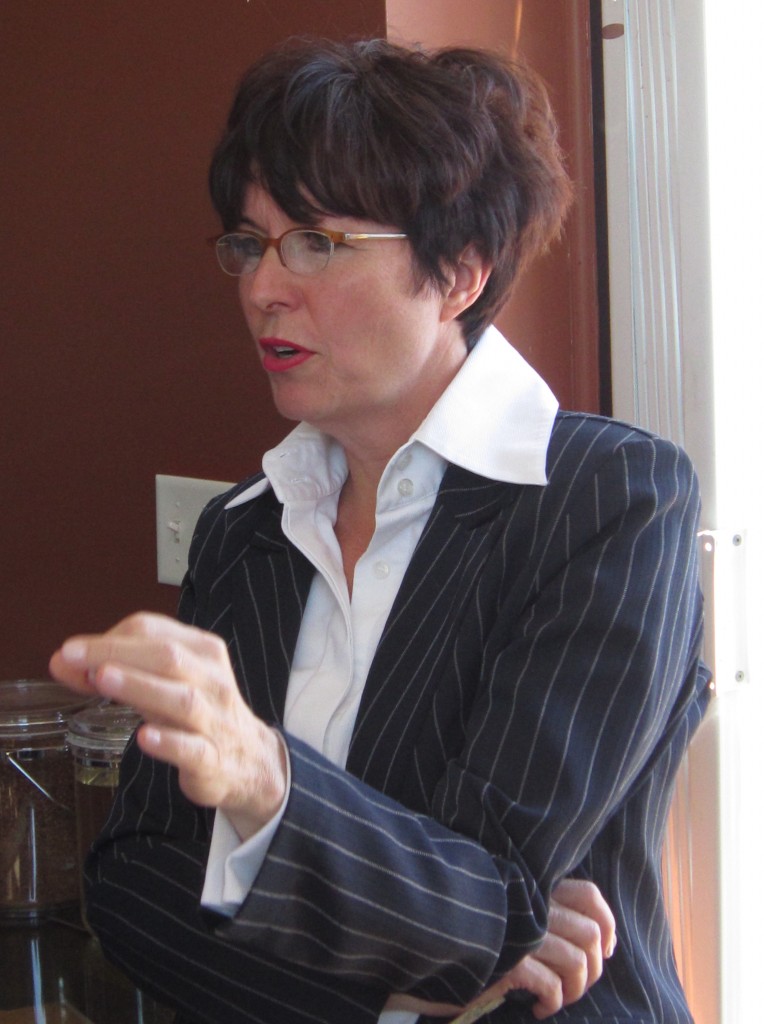 The Jane McKenna we saw during the election campaign wore the right Tory blue pin stripe suit and was taught to be earnest and direct with people. The Jane MC Kenna we saw at the Chamber of Commerce breakfast had a grip on the numbers that mattered and was capable of being as angry as an opposition MPP is supposed to be. But the Jane McKenna you see today is not the ‘didn’t know very much” that we saw six months ago. McKenna has a very impressive grip on the numbers part of what’s going on at Queen’s Park. It sounded as if she could give you a number on just about anything that was going on in the province. How much had been spent on the cancellation of the hydro plant in Mississauga or how much had been spent on the cancellation of the hydro plant in Oakville as well? McKenna has those numbers at her fingertips. Well not the Oakville numbers – and that has her getting ready to go after the Minister of Energy.
She did err a little on the size of the deficit – she threw out a $15 billion deficit number – when it is close to $13 billion. McKenna argues that “we are broke”. How broke? She maintains we are spending $1.8 million more a day than we are taking in and that 20% of the money we spend is borrowed money”. “It is bad” said McKenna and for a room filled with business people who know what it is to deal with a cash tight situation – McKenna was preaching to the converted.
McKenna wants to see an across the board pay cut to every civil servant. She has no problem with what the province is doing to the teachers – she wants the same thing done to everyone. I would assume that includes her own salary – which I’m pretty sure McKenna would say: Everyone means everyone.
 The Ornge helicopter scandal has McKenna bursting with indignation She railed at the 8.7% increase the MPAC people were given. (MPAC- Municipal Property Assessment Corporation – the people that determine the value of your home for tax purposes). Some 150 people attended the breakfast event at the Burlington Golf and Country Club where McKenna was described as heavily involved in the community. That was a bit of a stretch. What we appear to be seeing is a resume upgrade, which, if repeated often enough, will become truth.
Jane McKenna ran in one municipal election. She did so at the request of a colleague and came in dead last. She did run her own advertising sales agency and consulted for others on minor projects.
She did not intend to be a candidate for the Progressive Conservative nomination. She was, at the time, the campaign manager for a person who was asked by the party to step aside as a candidate for the nomination. Sometime after that candidate stepped aside, the PC association approached Jane McKenna, asked her to consider being the candidate and she took advantage of the opportunity. If you know Keith Strong – you know how that conversation went.
What we appear to be seeing is a Member of the provincial Legislature becoming exceptionally political – we don’t see this kind of political posturing from Mike Wallace the Conservative member of the House of Commons for Burlington.
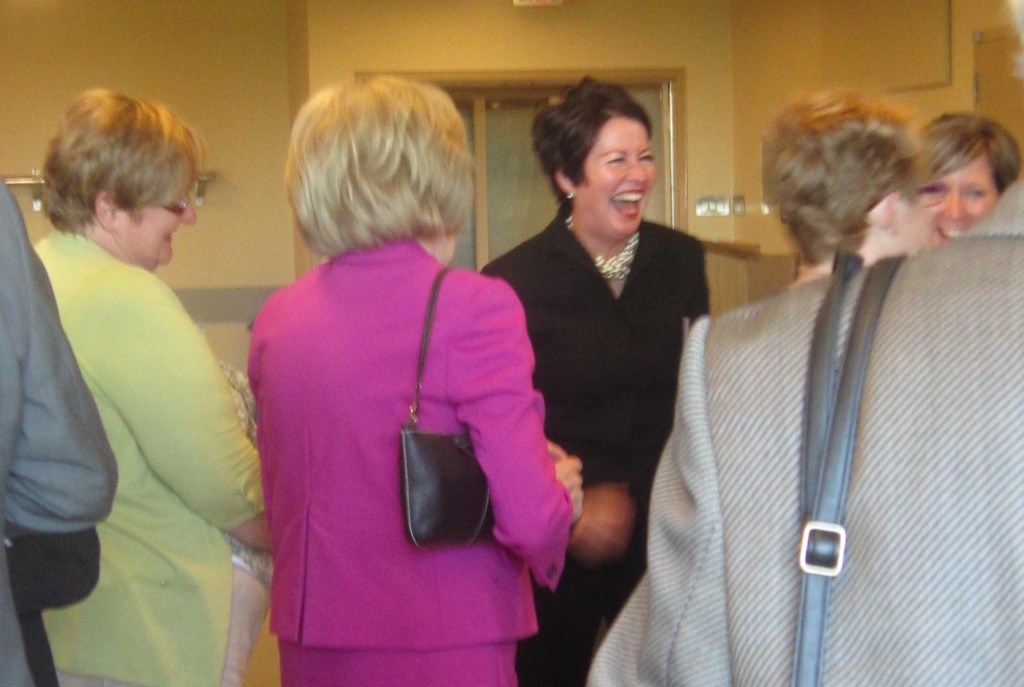 Jane McKenna yuks it up with guests at the Joseph Brant hospital annual meeting. A few months earlier she couldn’t get in the place to attend a meeting with the Liberal Health Minister who was delivering cheques. McKenna is creating a political persona of a politician that has a deep understanding of what the government is doing and where they are making their mistakes. It will all be very political. Is this something McKenna has decided to do on her own or is this something her handlers are creating? Whichever, anyone who thought she would be a knock off in the next provincial election is in for a surprise. We won’t see the fumbling that we saw at the Central High School debate. McKenna is now much more confident and while she may not fully understand the issues and their longer term implications – she can and will throw numbers at you until your dizzy.
She nailed Chris Bentley, Minister of Energy for his failure to provide information to a Legislative committee last May. Secret documents on the cost of scrapping the Oakville power plant — located in a Liberal riding, — must be released, the Speaker of Ontario’s legislature ruled Thursday, the day before McKenna talked to the Chamber crowd. Basically the Liberal Energy Minister was on the verge of a rare contempt of parliament censure for refusing to release the documents.
McKenna will pounce all over the Minister on this one – and she’s right. The Liberals pulled a fast one during the provincial election – and got away with it.
They tried the same thing in Kitchener-Waterloo where they caused a by-election to be held after offering a nice plum to Elizabeth Witmer, the sitting member, who was not very happy with PC leader Tim Hudak and was quite prepared to leave the Legislature.
Liberal leader Dalton McGuinty and his political advisers thought they could win the seat. A win in Kitchener-Waterloo along with the all but guaranteed win in Vaughan and the Liberals would have the majority they didn’t win during the provincial election. The New Democrats spoiled that plan and they won the seat.
McKenna told the Chamber breakfast that her party didn’t have a platform during the by-election. That’s a pretty bold admission; refreshing.
McKenna does have PC leader Tim Hudak’s ear and she has some clout, partially because of her energy and drive. McKenna told the breakfast meeting that when she got to Queen’s Park she was “shocked. The process didn’t work. The Ornge hospital helicopter disaster and the $300 million loans the Health Minister didn’t know about” “The shutting down of the two power plants. Where does it stop? I knew absolutely nothing about this stuff before I got to Queen’s Park”, she said.
McKenna wants much more transparency and accountability, which is easy to call for when you are in opposition. How will McKenna handle things if she is part of a government and learns that that is the way government does things – you say nothing unless you have to and then you put out a press release late on the Friday afternoon of a long weekend.
Is McKenna going to be the fresh face of provincial politics? Not in the next three years and if she is part of a government it will not be one led by Tim Hudak. Is McKenna leadership material? Not yet and a little too early to tell if she has real leadership within her.
McKenna talks about being big on “transparency”. “Everything we do is on line” she told her office. Sure, if you know the name of the document and you are aware it is actually on a web site. McKenna doesn’t send out press releases from her office. She will answer direct questions if you can get some face time with her.
When the city of Burlington used some “political protocol” nonsense to keep McKenna away from an event that had the Liberal member Ted McMeekin, the closest Cabinet Minister to Burlington, talking about the money the province put up for the Community Garden project – McKenna talked to Our Burlington and at the time didn’t fully understand why she was being “uninvited”. We did a small piece on the stupid position the city had taken.
McKenna, like her or not, is Burlington’s representative at Queen’s Park. She got shut out of meeting when the Minister of Health was at the hospital talking about the funding JBMH eventually got from the province.
McKenna, has real “cahonies” when it comes to being brash and bold. The woman knows no shame (that is meant as a compliment) when it comes to going after what she wants.
Politics is all about power. With a majority in the Legislature a political party can do almost anything it wants. The Tories aren’t in power but then neither are the Liberals. The New Democrats were offering the people in Kitchener-Waterloo what they wanted and they ran a better campaign and won the seat.
Jane McKenna is growing as a politician. A little less stridency, more reflection and over time she could become a Charlotte Whitton – all the Tories that matter in this town will remember her – and nod approvingly.
Can McKenna make that transition. It will be a challenge.

 Part 4 of a 4 part Terry Fox Run photo essay. Part 4 of a 4 part Terry Fox Run photo essay.
By Pepper Parr
BURLINGTON, ON September 17, 2012 It was for the COZ – there were close to 200 people wearing the small piece of paper that read Team Casey.
There were T-shirts, several handmade creations that said they were there to support Casey Cosgrove as he battles cancer.
 Parts of Team Cosgrove As Deb Tymstra was having the walkers get into the line in front of the starting gate – someone had Team Casey at the other side of the starting gate. There were so many Team Casey people that the walkers couldn’t get started until the Team Casey people were out of the way. So Deb Tymstra put them through a warm up exercise given by the Cedar spring ladies. Eventually, the photo shoot was done and the Team Casey people worked themselves into the walking line and Don Pace did the – Get Ready, Get Set and Go call.
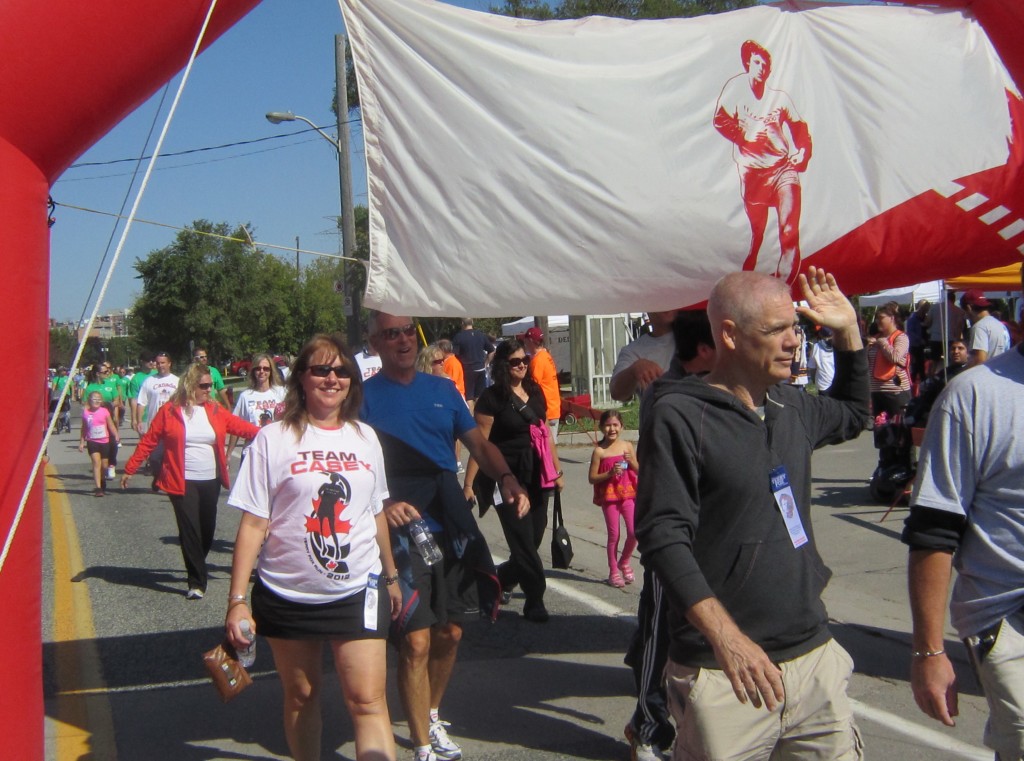 The Team Casey members were easily recognized. Besides being the biggest group they were probably the noisiest as well. There was never any doubt when a team member crossed the finish line. They were walking for Casey Cosgrove and along the way appreciating who he was and what he has done for his community. They thought about the really funny stuff that pops up on his Facebook page and they wondered as well about how much Terry Fox has done for cancer research.
It is cancer research breakthroughs that offer Casey the hope and the opportunity to beat the cancer he battles. Casey is quite open about his struggle. He has good days and bad days – but he has hundreds of friends to support him.
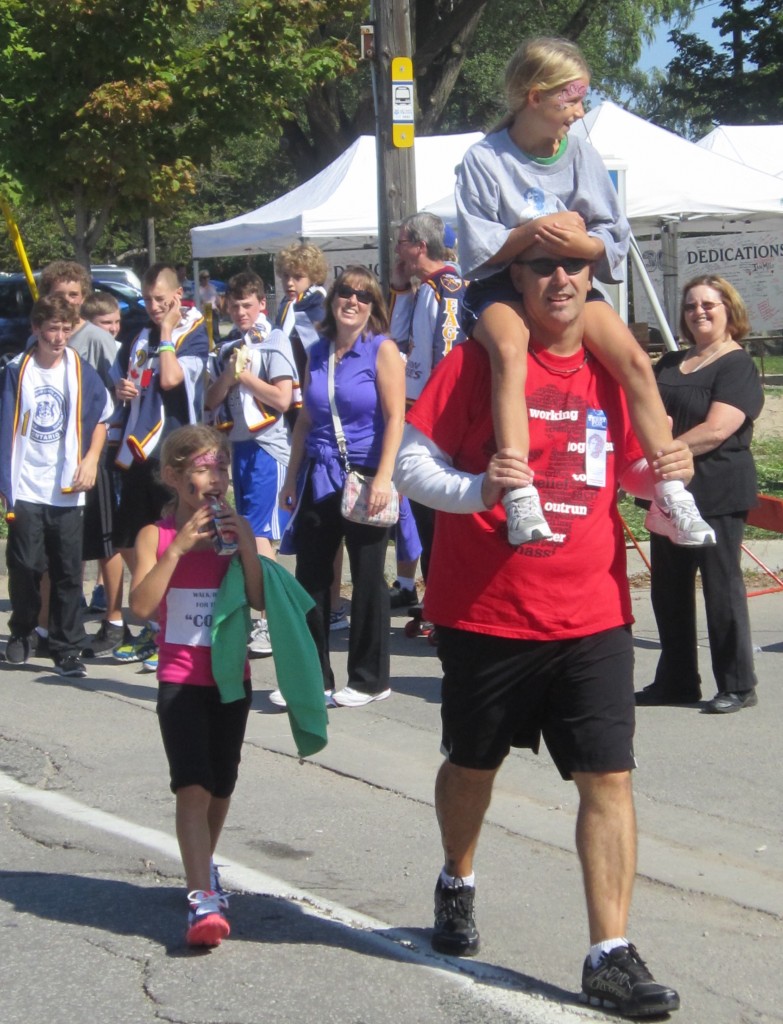 Part of bearing the load. Top two members of Team Cosgrove Terry Fox brought the same robust attitude to his situation: he refused to regard himself as disabled, and would not allow anyone to pity him, telling a Toronto radio station that he found life more “rewarding and challenging” since he had lost his leg. His feat helped redefine Canadian views of disability and the inclusion of the disabled in society. Fox’s actions increased the visibility of people with disabilities, and in addition influenced the attitudes of those with disabilities, by showing them disability portrayed in a positive light. Rick Hansen commented that the run challenged society to focus on ability rather than disability. “What was perceived as a limitation became a great opportunity. People with disabilities started looking at things differently. They came away with huge pride”, he wrote.
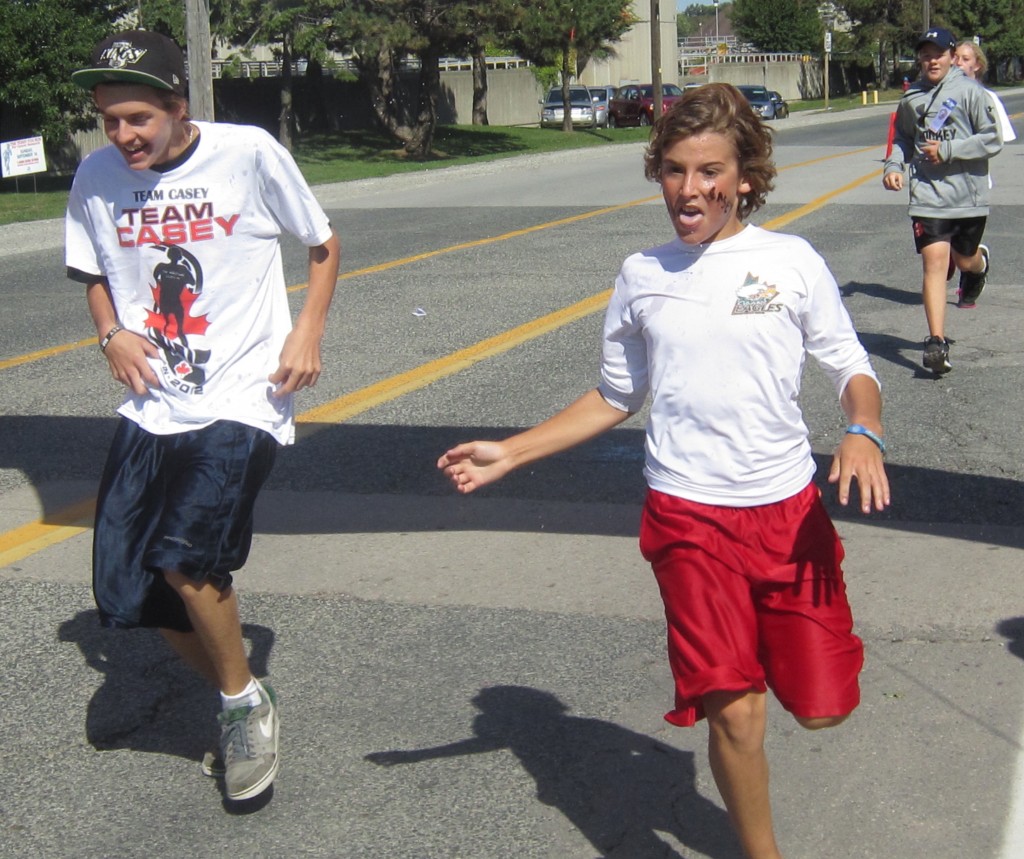 Two members of Team Casey giving it that final push. Casey Cosgrove has taught thousands how to deal with health adversity. Some disabled people are made to feel like failures if they haven’t done something extraordinary. Casey is just an ordinary guy doing his best and giving just as much as he is getting.
One of Fox’s earliest supporters was Isadore Sharp, founder of the Four Seasons Hotels. Sharp had lost his own son to cancer and offered Fox and his companions free accommodation at his hotels. He donated $10,000 and challenged 999 other businesses to do the same. Sharp also proposed an annual fundraising run in Fox’s name. Fox agreed, but insisted that the runs be non-competitive. There were to be no winners or losers, and anyone who participated could run, walk or ride. Sharp faced opposition to the project. The Cancer Society feared that a fall run would detract from its traditional April campaigns, while other charities believed that an additional fundraiser would leave less money for their causes. Sharp persisted, and he, the Four Seasons Hotels and the Fox family organized the first Terry Fox Run on September 13, 1981.
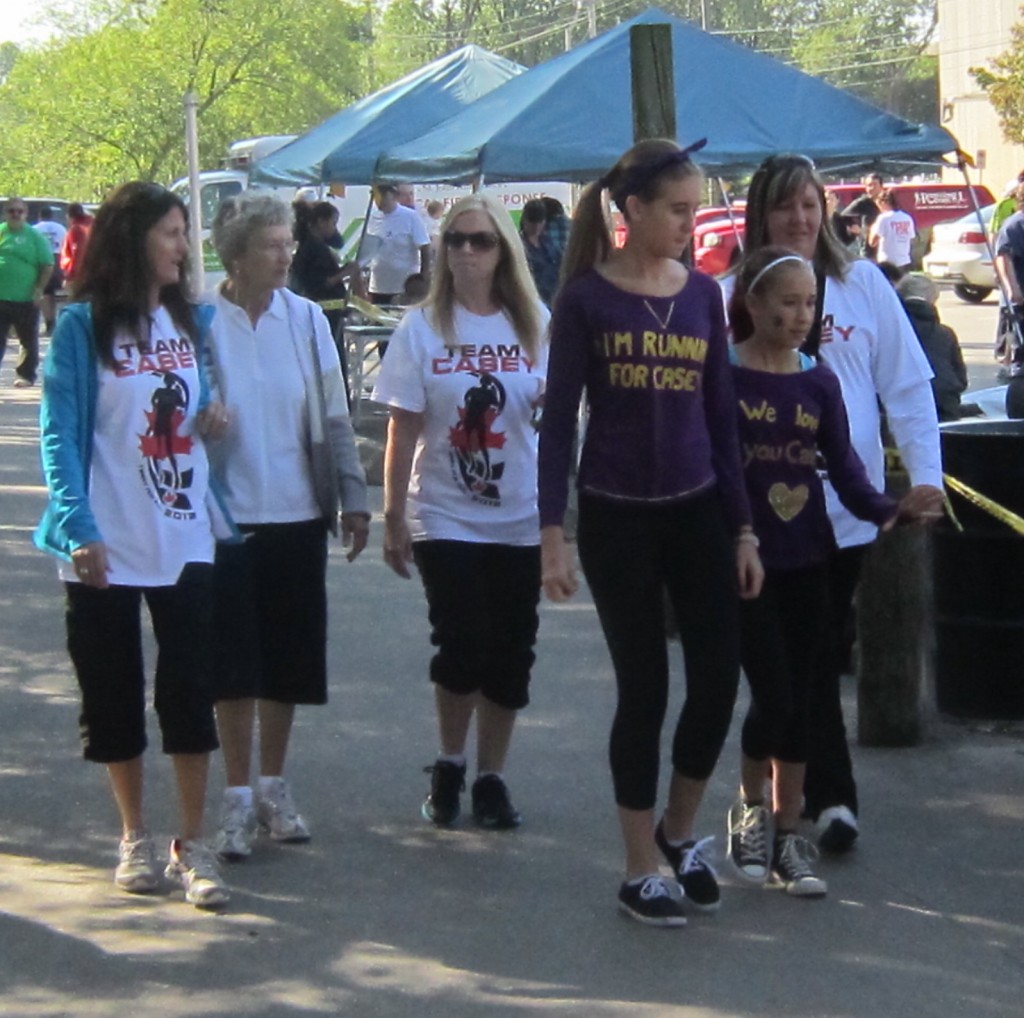 Some members of Team Cosgrove made their own sweaters. One of those has to be used in the Spiral submission for the Performing arts Centre if that submission is chosen. Over 300,000 people took part and raised $3.5 million in the first Terry Fox Run. 4000 of those dollars came from Burlington.
Schools across Canada were urged to join the second run, held on September 19, 1982, and now have their own National School Run Day. The runs, which raised over $20 million in its first six years, grew into an international event as over one million people in 60 countries took part in 1999, raising $15 million that year alone.
Last Sunday, in Burlington, more than 1000 people did the run – and 200 of them were there for Casey Cosgrove and the COZ.
Part 1 of 4
Part 2 of 4
Part 3 of 4

 By Pepper Parr By Pepper Parr
BURLINGTON, ON September 16, 2012 There are hundreds of people who took part in the Terry Fox run last Sunday who aren’t up to annual run but they nevertheless see this as an important annual event. Many have seen cancer threaten their families, others have lost members of their families or friends to the disease. The occasion for them is an opportunity to reflect and remember and pray for those fighting the disease. They want too, to contribute to the research and help find more of the root causes of cancer.
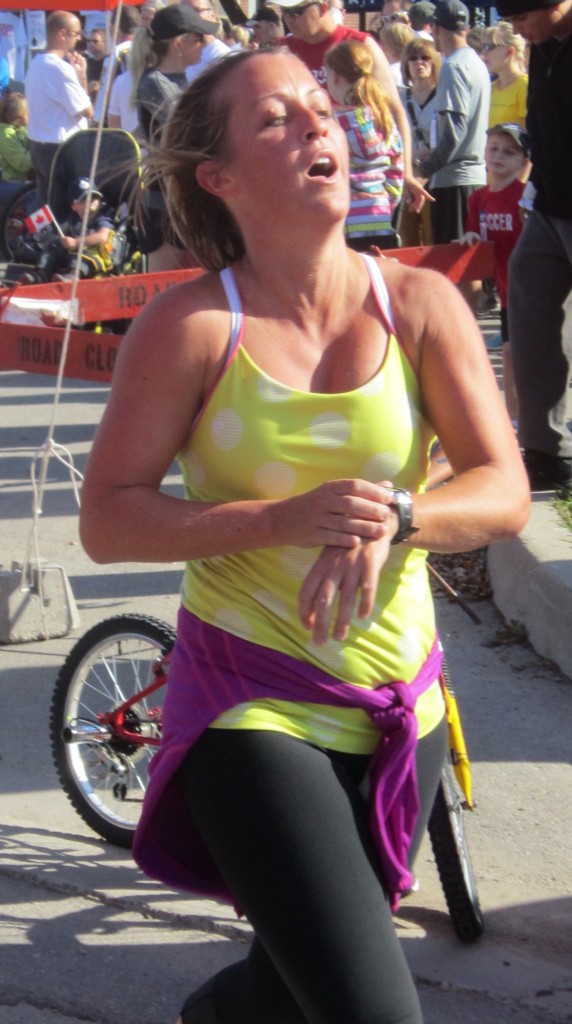 She’s either taking her pulse or checking her time. A very solid run. 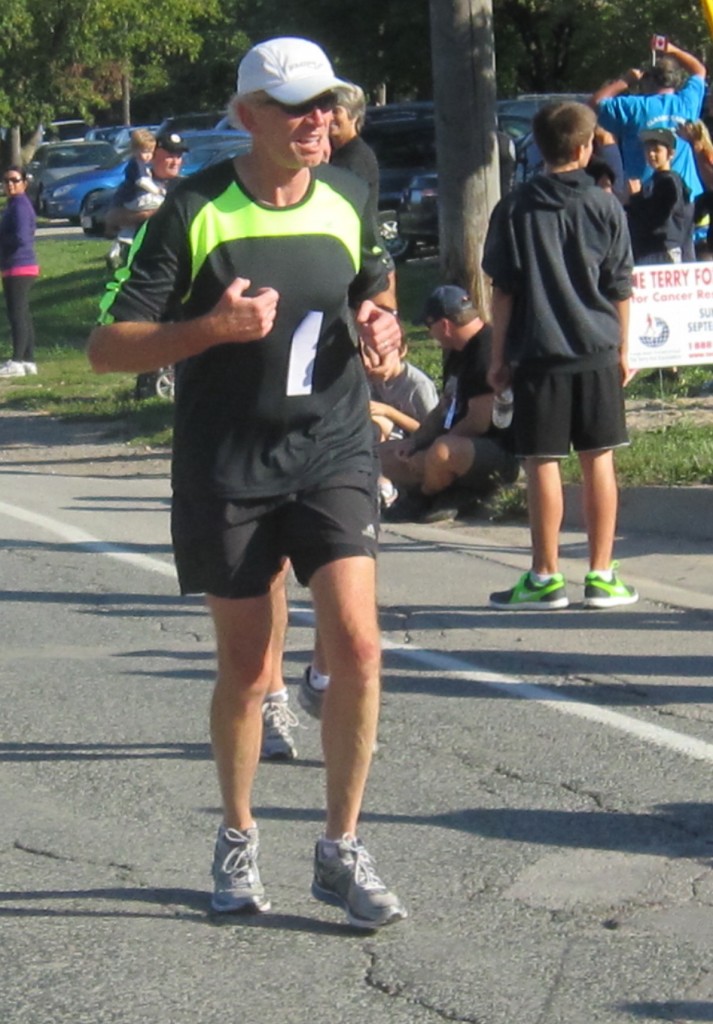 Nice steady pace gets this runner to the finish line during the Terry Fox Run for cancer research. We’ve learned how damaging smoking was – but we didn’t know back in 1980 what we certainly know now about cigarette smoking – yet many of our youth still light up. We have work to do on the cancer research side as well as changing attitudes amongst some of our younger people.
On November 12, 1976, Terry Fox was driving home to Port Coquitlam, and became distracted by nearby bridge construction, and crashed into the back of a pickup truck. While his car was left a wreck that couldn’t be driven, Fox emerged with only a sore right knee.
He again felt pain in the knee a month later, but chose to ignore it until the end of basketball season. By March 1977, the pain had intensified and he finally went to a hospital, where he was diagnosed with osteosarcoma, a form of cancer that often starts near the knees. Fox believed his car accident weakened his knee and left it vulnerable to the disease, though his doctors argued there was no connection. He was told that his leg had to be amputated, he would require chemotherapy treatment, and that recent medical advances meant he had a 50 percent chance of survival. Fox learned that two years before the figure would have been only 15 percent; the improvement in survival rates impressed on him the value of cancer research.
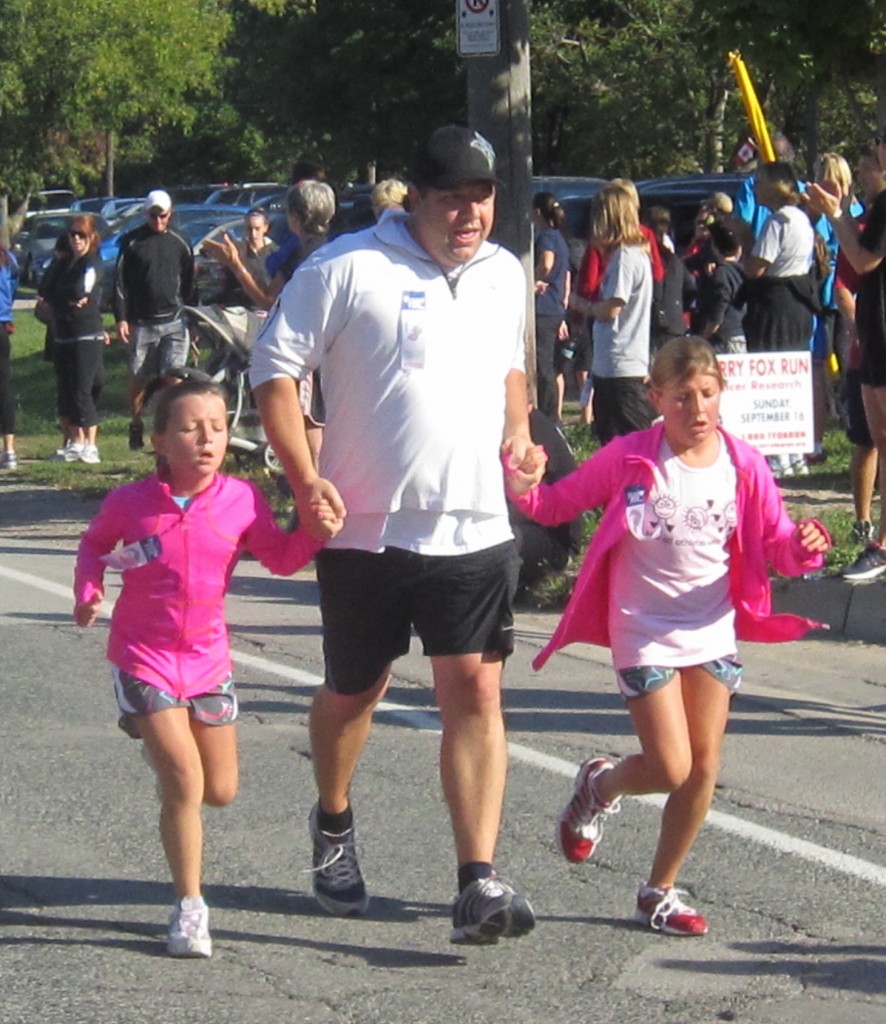 Big fund raisers doing the run. 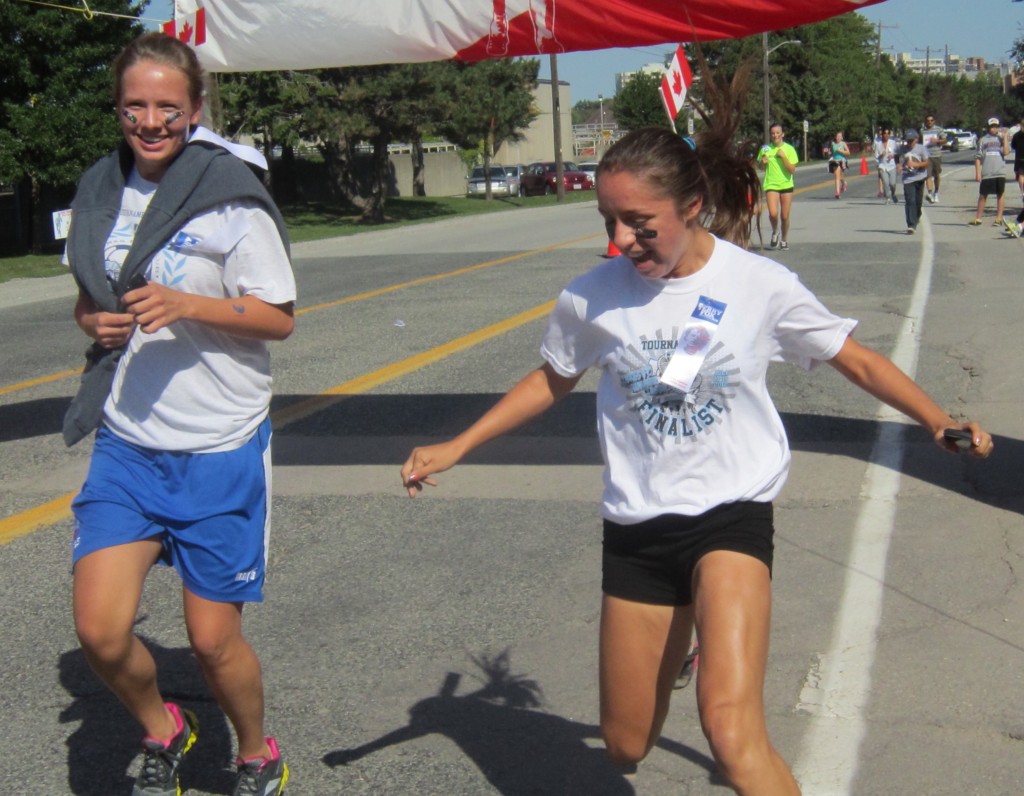 That was absolutely awesome. With the help of an artificial leg, Fox was walking three weeks after the amputation. He then progressed to playing golf with his father. Doctors were impressed with Fox’s positive outlook, stating it contributed to his rapid recovery. He endured sixteen months of chemotherapy and found the time he spent in the British Columbia Cancer Control Agency facility difficult as he watched fellow cancer patients suffer and die from the disease. Fox ended his treatment with new purpose: he felt he owed his survival to medical advances and wished to live his life in a way that would help others find courage.
In the summer of 1977 Rick Hansen, working with the Canadian Wheelchair Sports Association, invited Fox to try out for his wheelchair basketball team. Although he was undergoing chemotherapy treatments at the time, Fox’s energy impressed Hansen. Less than two months after learning how to play the sport, Fox was named a member of the team for the national championship in Edmonton. He won three national titles with the team, and was named an all-star by the North American Wheelchair Basketball Association in 1980.
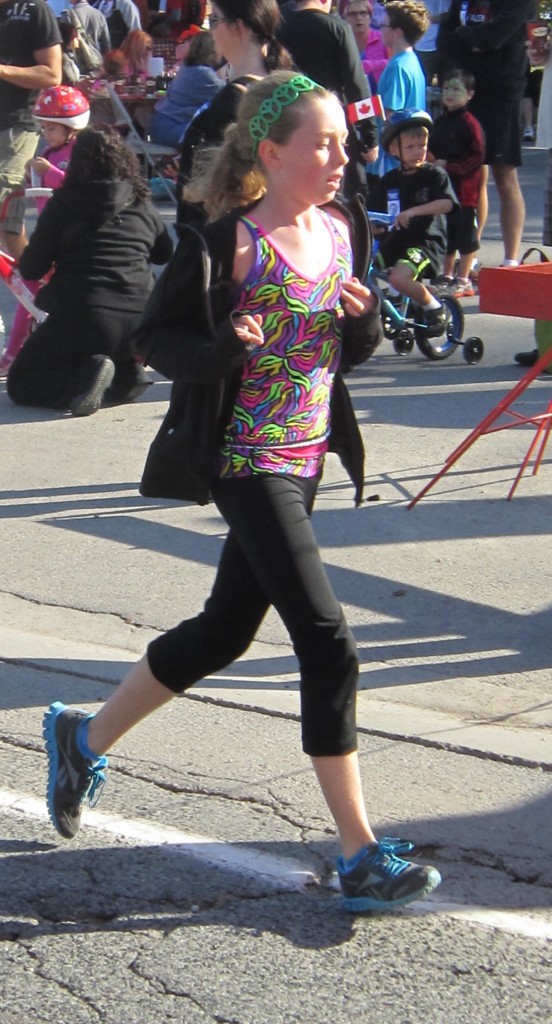 The balance between young and middle aged runners was basically equal. 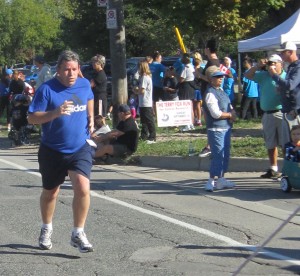 The balance between male and female was also close to even. No one group dominated the event. The night before his cancer surgery, Fox had been given an article about Dick Traum, the first amputee to complete the New York City Marathon. The article inspired him; he embarked on a 14-month training program, telling his family he planned to compete in a marathon himself. In private, he devised a more extensive plan. His hospital experiences had made Fox angry at how little money was dedicated to cancer research. He intended to run the length of Canada in the hope of increasing cancer awareness, a goal he initially only divulged to his friend Douglas Alward.
Fox ran with an unusual gait, as he was required to hop-step on his good leg due to the extra time the springs in his artificial leg required to reset after each step. He found the training painful as the additional pressure he had to place on both his good leg and his stump led to bone bruises, blisters and intense pain. Fox found that after about 20 minutes of each run, he crossed a pain threshold and the run became easier.
In August 1979, Fox competed in a marathon in Prince George, British Columbia. He finished in last place, ten minutes behind his closest competitor, but his effort was met with tears and applause from the other participants. Following the marathon, he revealed his full plan to his family. His mother discouraged him, angering Fox, though she later came to support the project. She recalled, “He said, ‘I thought you’d be one of the first persons to believe in me.’ And I wasn’t. I was the first person who let him down”. Fox initially hoped to raise $1 million, then $10 million, but later sought to raise $1 for each of Canada’s 24 million people.
 Many made it a family day – several just slept through the event. 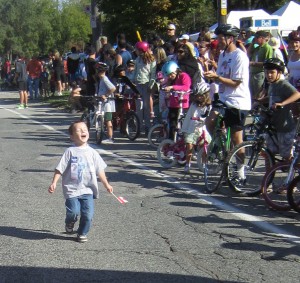 This guy was going to do it all on his won. . On October 15, 1979, Fox sent a letter to the Canadian Cancer Society in which he announced his goal and appealed for funding. He stated that he would “conquer” his disability, and promised to complete his run, even if he had to “crawl every last mile”. Explaining why he wanted to raise money for research, Fox described his personal experience of cancer treatment, Fox said: “soon realized that that would only be half my quest, for as I went through the 16 months of the physically and emotionally draining ordeal of chemotherapy, I was rudely awakened by the feelings that surrounded and coursed through the cancer clinic. There were faces with the brave smiles, and the ones who had given up smiling. There were feelings of hopeful denial, and the feelings of despair. My quest would not be a selfish one. I could not leave knowing these faces and feelings would still exist, even though I would be set free from mine. Somewhere the hurting must stop….and I was determined to take myself to the limit for this cause”.
Fox made no promises that his efforts would lead to a cure for cancer, but he closed his letter with the statement: “We need your help. The people in cancer clinics all over the world need people who believe in miracles. I am not a dreamer, and I am not saying that this will initiate any kind of definitive answer or cure to cancer. I believe in miracles. I have to.”
 Smart enough to hydrate with a smile that made this an easy picture to take. 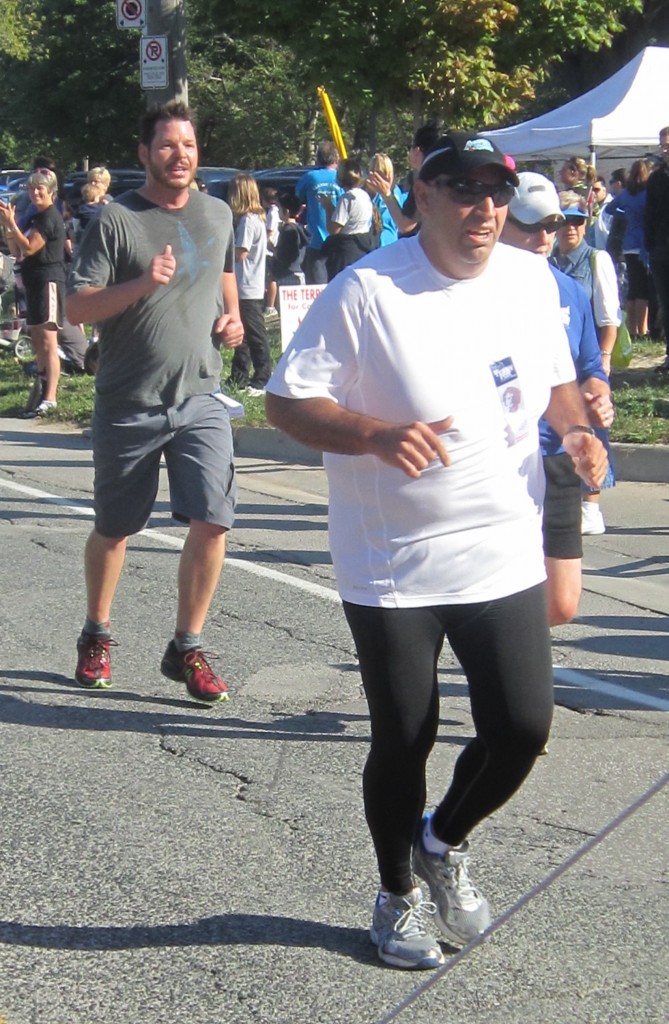 You’ve seen his picture before – on an election poster. He was smiling then The Cancer Society was skeptical of his dedication, but agreed to support Fox once he had acquired sponsors and requested he get a medical certificate from a heart specialist stating that he was fit to attempt the run. Fox was diagnosed with left ventricular hypertrophy — an enlarged heart — a condition commonly associated with athletes. Doctors warned Fox of the potential risks he faced, though they did not consider his condition a significant concern. They endorsed his participation when he promised that he would stop immediately if he began to experience any heart problems.
A second letter was sent to several corporations seeking donations for a vehicle, running shoes and to cover the other costs of the run. Fox sent other letters asking for grants to buy a running leg. He observed that while he was grateful to be alive following his cancer treatment, “I remember promising myself that, should I live, I would rise up to meet this new challenge of fundraising for cancer research face to face and prove myself worthy of life, something too many people take for granted.”
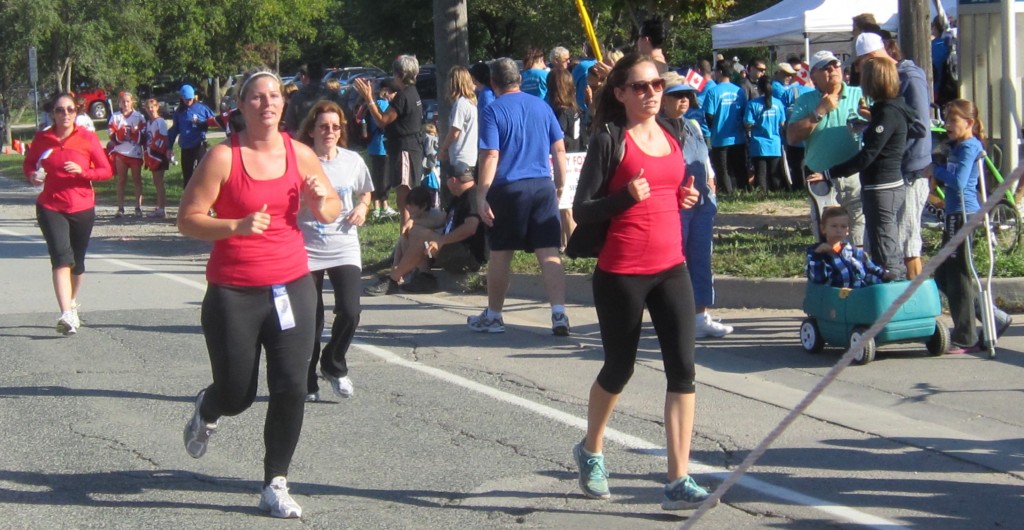 Red seemed to be the dominant colour of the day. The Ford Motor Company donated a camper van, while Imperial Oil contributed fuel, and Adidas his running shoes. Fox turned away any company that requested he endorse their products and refused any donation that carried conditions as he insisted that nobody was to profit from his run.
The Marathon began on April 12, 1980, when Fox dipped his right leg in the Atlantic Ocean near St. John’s, Newfoundland, and filled two large bottles with ocean water. He intended to keep one as a souvenir and pour the other into the Pacific Ocean upon completing his journey at Victoria, British Columbia. Fox was supported on his run by Doug Alward, who drove the van and cooked meals.
It was at about this time that Don Pace heard the story and knew there had to be a Terry Fox run in Burlington. He organized the 1981 and 1982 events and was the official starter for the races last weekend.
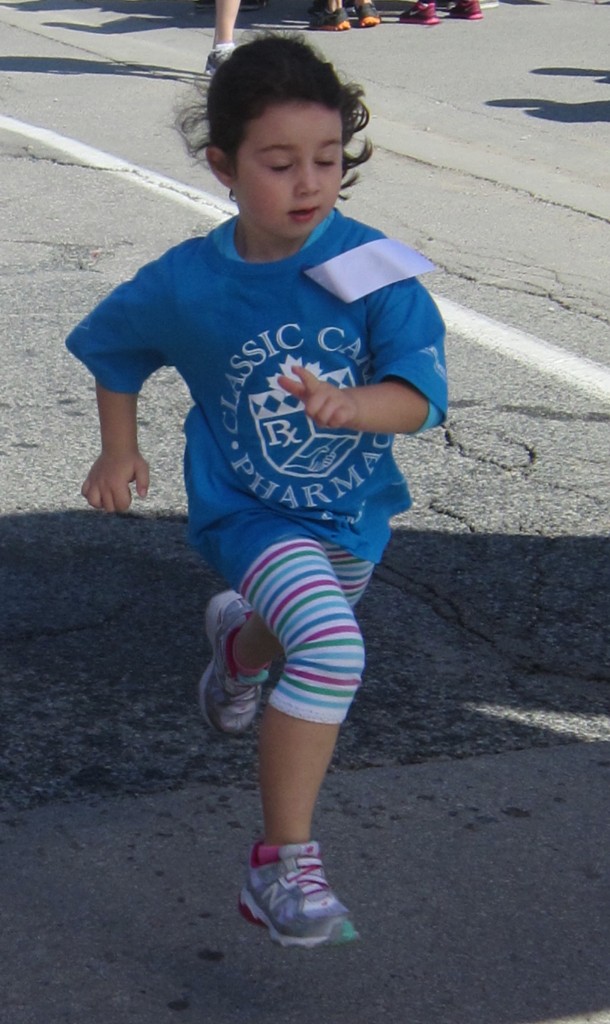 Classic Care Pharmacy certainly had the largest corporate presence during the runs and the walks. Fox was met with gale force winds, heavy rain and a snowstorm in the first days of his run. He was initially disappointed with the reception he received, but was heartened upon arriving in Port aux Basques, Newfoundland, where the town’s 10,000 residents presented him with a donation of over $10,000. Throughout the trip, Fox frequently expressed his anger and frustration to those he saw as impeding the run, and he fought regularly with Alward. By the time they reached Nova Scotia, they were barely on speaking terms, and it was arranged for Fox’s brother Darrell, then 17, to join them as a buffer.
 Determination and grit got this woman over the finish line. It was the same story for hundreds of both walkers and runners. Deb Tymstra on the right calling the runners in. Fox left the Maritimes on June 10 and faced new challenges entering Quebec due to his group’s inability to speak French and drivers who continually forced him off the road. Fox arrived in Montreal on June 22, one-third of the way through his 8,000-kilometre (5,000 mi) journey, having collected over $200,000 in donations. Around this time, Terry Fox’s run caught the attention of Isadore Sharp who was the founder and CEO of Four Seasons Hotel and Resorts—and who had lost a son to melanoma in 1978 just a year after Terry’s diagnosis. Sharp was intrigued by the story of a one-legged kid “trying to do the impossible” and run across the country; so he offered food and accommodation at his hotels en route. When Terry was discouraged because so few people were making donations, Sharp pledged $2 a mile to the run and persuaded close to 1,000 other corporations to do the same. Sharp’s encouragement persuaded Terry to continue with the Marathon of Hope. Convinced by the Canadian Cancer Society that arriving in Ottawa for Canada Day would aid fundraising efforts, he remained in Montreal for a few extra days.
Fox crossed into Ontario at the town of Hawkesbury on the last Saturday in June. He was met by a brass band and thousands of residents who lined the streets to cheer him on, while the Ontario Provincial Police gave him an escort throughout the province. Despite the sweltering heat of summer, he continued to run 26 miles (42 km) per day. On his arrival in Ottawa, Fox met Governor General Ed Schreyer and Prime Minister Pierre Trudeau and was the guest of honour at numerous sporting events in the city. In front of 16,000 fans, he performed a ceremonial kickoff at a Canadian Football League game and was given a standing ovation. Fox’s journal reflected his growing excitement at the reception he had received as he began to understand how deeply moved Canadians were by his efforts.
A crowd of 10,000 people met Fox in Toronto, where he was honoured in Nathan Phillips Square. As he ran to the square, he was joined on the road by many people, including National Hockey League star Darryl Sittler, who presented Fox with his 1980 All-Star Game jersey. The Cancer Society estimated it collected $100,000 in donations that day alone. As he continued through southern Ontario, he was met by Hockey Hall of Famer Bobby Orr who presented him with a cheque for $25,000. Fox considered meeting Orr the highlight of his journey.
 This guy was going to make it – without any help from his Mother. Two younger runners come up the rear racing for the finish line. “Everybody seems to have given up hope of trying. I haven’t. It isn’t easy and it isn’t supposed to be, but I’m accomplishing something. How many people give up a lot to do something good. I’m sure we would have found a cure for cancer 20 years ago if we had really tried”
As Fox’s fame grew, the Cancer Society scheduled him to attend more functions and give more speeches. Fox attempted to accommodate any request that he believed would raise money, no matter how far out of his way it took him. He bristled, however, at what he felt were media intrusions into his personal life, for example when the Toronto Star reported that he had gone on a date. Fox was left unsure whom he could trust in the media after negative articles began to emerge, including one by the Globe and Mail that characterized him as a “tyrannical brother” who verbally abused Darrell and claimed he was running because he held a grudge against a doctor who had misdiagnosed his condition, allegations he referred to as “trash”.
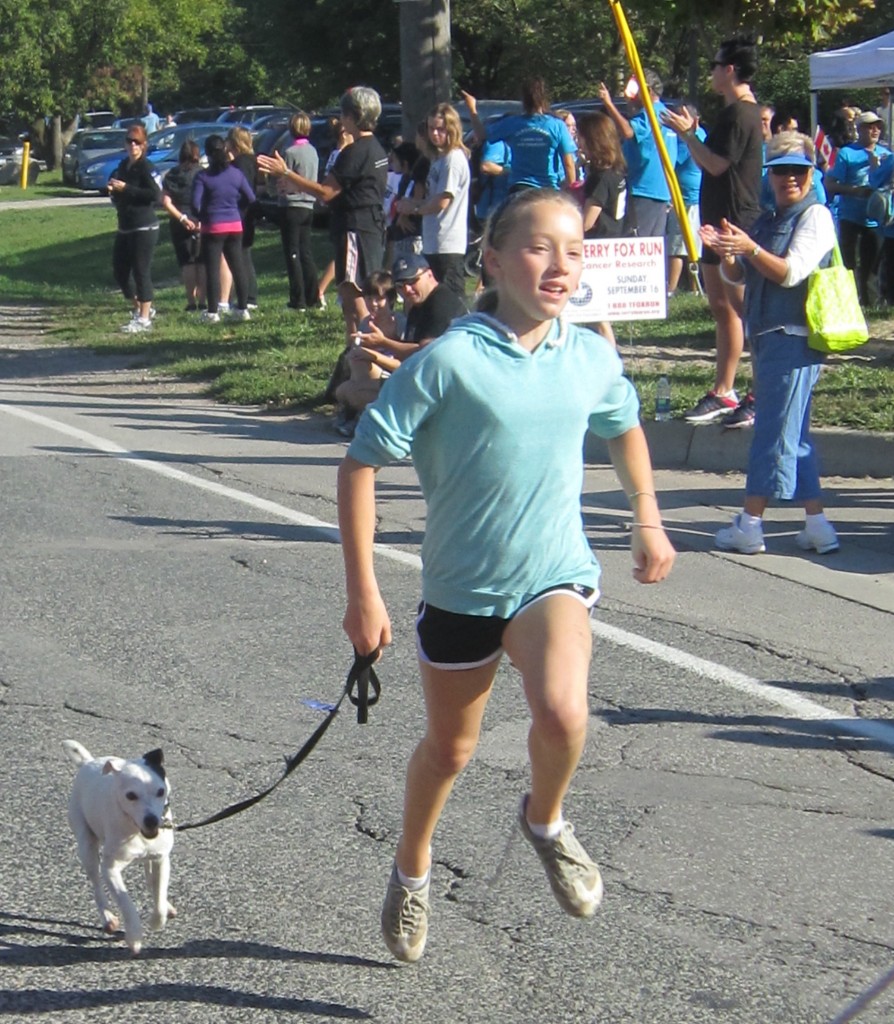 A lively step from this young lady as she leads the dog into the finish line.  Lots of water to handle the dehydration. The physical demands of running a marathon every day took its toll on Fox’s body. Apart from the rest days in Montreal taken at the request of the Cancer Society, he refused to take a day off, even on his 22nd birthday. He frequently suffered shin splints and an inflamed knee. He developed cysts on his stump and experienced dizzy spells. At one point, he suffered a soreness in his ankle that would not go away. Although he feared he had developed a stress fracture, he ran for three more days before seeking medical attention, and was then relieved to learn it was tendonitis and could be treated with painkillers. Fox rejected calls for him to seek regular medical checkups, and dismissed suggestions he was risking his future health.
In spite of his immense recuperative capacity, Fox found that by late August he was exhausted before he began his day’s run. On September 1, outside of Thunder Bay, he was forced to stop briefly after he suffered an intense coughing fit and experienced pains in his chest. Unsure what to do, he resumed running as the crowds along the highway shouted out their encouragement. A few miles later, short of breath and with continued chest pain, he asked Alward to drive him to a hospital. He feared immediately that he had run his last kilometer. The next day, Fox held a tearful press conference during which he announced that his cancer had returned and spread to his lungs. He was forced to end his run after 143 days and 5,373 kilometres (3,339 mi). Fox refused offers to complete the run in his stead, stating that he wanted to complete his marathon himself.
Fox had raised $1.7 million by the time he was forced to abandon the Marathon. He realized that the nation was about to see the consequences of the disease, and hoped that this might lead to greater generosity. A week after his run ended, the CTV Television Network organized a nationwide telethon in support of Fox and the Canadian Cancer Society. Supported by Canadian and international celebrities, the five-hour event raised $10.5 million. Among the donations were $1 million each by the governments of British Columbia and Ontario, the former to create a new research institute to be founded in Fox’s name, and the latter an endowment given to the Ontario Cancer Treatment and Research Foundation. Donations continued throughout the winter, and by the following April, over $23 million had been raised.
Supporters and well wishers from around the world inundated Fox with letters and tokens of support. At one point, he was receiving more mail than the rest of Port Coquitlam combined. Such was his fame that one letter addressed simply to “Terry Fox, Canada” was successfully delivered.
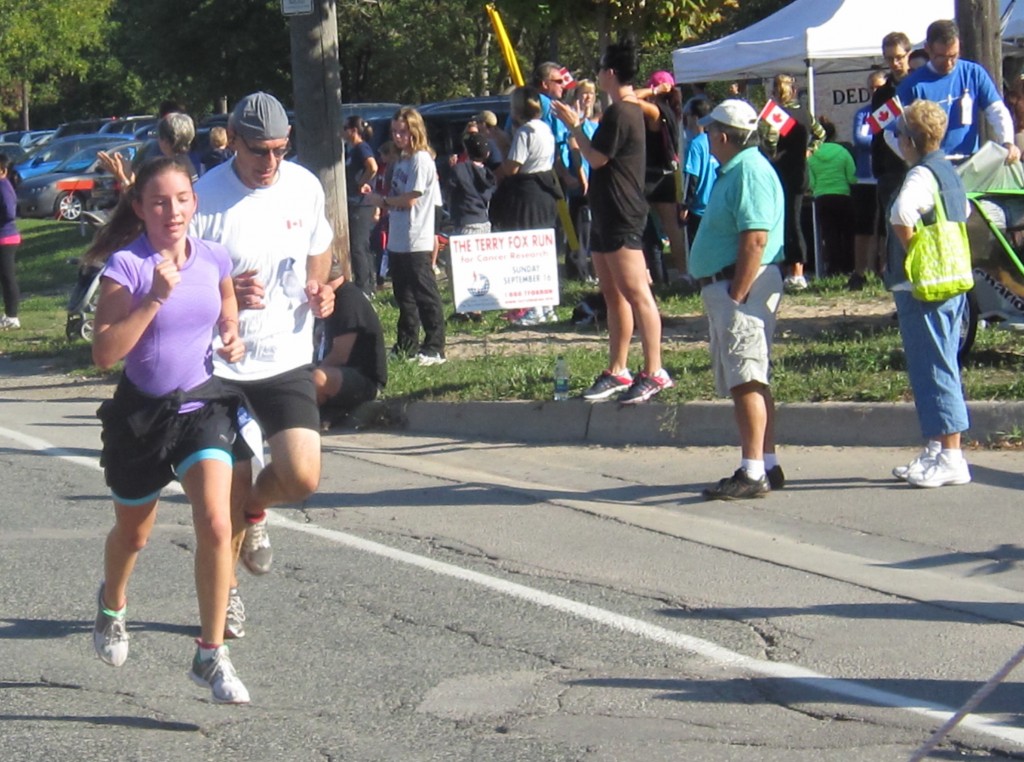 Young girl beats her Dad in the home stretch of the Burlington 2012 Terry Fox Run for cancer research In September 1980 he was invested in a special ceremony as a Companion of the Order of Canada; he was the youngest person to be so honoured. The Lieutenant Governor of British Columbia named him to the Order of the Dogwood, the province’s highest award. Canada’s Sports Hall of Fame commissioned a permanent exhibit, and Fox was named the winner of the Lou Marsh Award for 1980 as the nation’s top athlete. He was named Canada’s 1980 Newsmaker of the Year. The Ottawa Citizen described the national response to his marathon as “one of the most powerful outpourings of emotion and generosity in Canada’s history”.
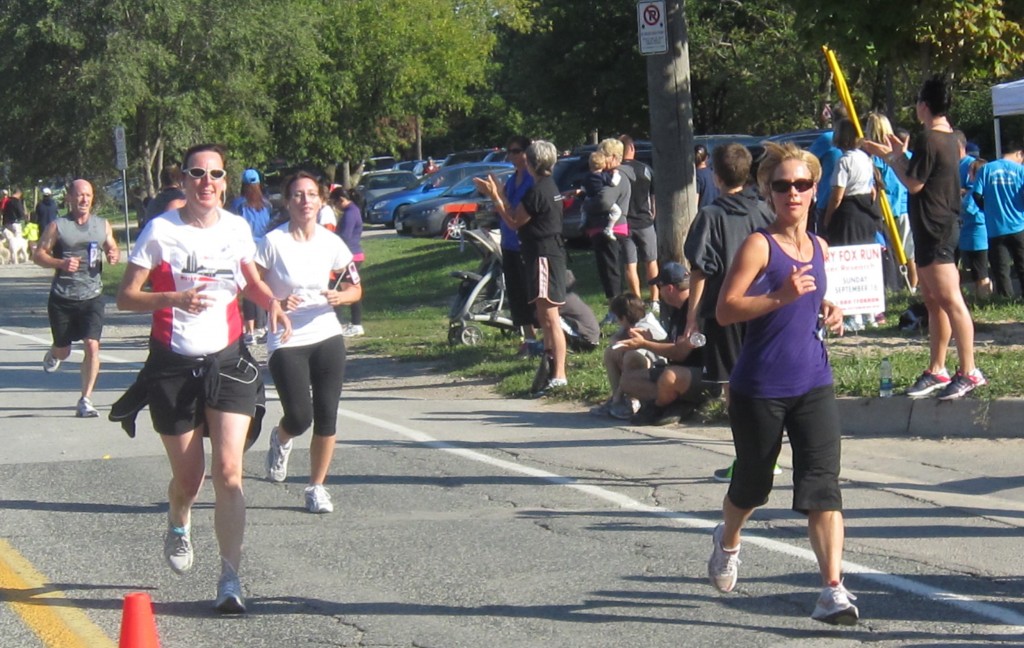 Each of these woman had their own reasons for running this race and each ran it in their own way. Hundreds did just this during the Terry Fox Run for cancer research In the following months, Fox received multiple chemotherapy treatments; however, the disease continued to spread. As his condition worsened, Canadians hoped for a miracle and Pope John Paul II sent a telegram saying that he was praying for Fox. Doctors turned to experimental interferon treatments, though their effectiveness against osteogenic sarcoma was unknown. He suffered an adverse reaction to his first treatment, but continued the program after a period of rest.
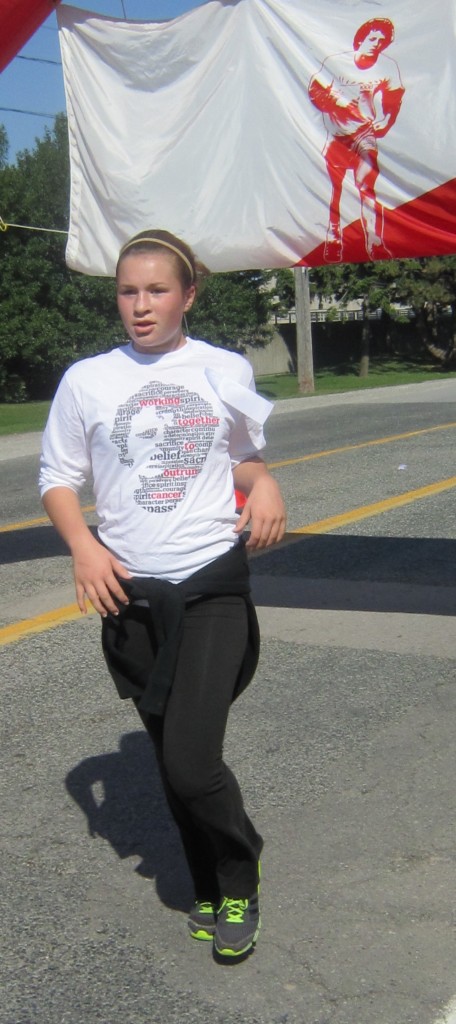 The T-shirt said it all – the expression on this young woman’s face told us why she is running  “It was a grind” she said after crossing the finish line “But I’m glad I did this run.” Fox was re-admitted to the Royal Columbian Hospital in New Westminster on June 19, 1981, with chest congestion and developed pneumonia. He fell into a coma and died at 4:35 a.m. PDT on June 28, 1981, with his family by his side. The Government of Canada ordered flags across the country lowered to half-staff, an unprecedented honour that was usually reserved for statesmen. Addressing the House of Commons, Trudeau said, “It occurs very rarely in the life of a nation that the courageous spirit of one person unites all people in the celebration of his life and in the mourning of his death … We do not think of him as one who was defeated by misfortune but as one who inspired us with the example of the triumph of the human spirit over adversity”.
His funeral, was broadcast on national television; hundreds of communities across Canada also held memorial services, a public memorial service was held on Parliament Hill in Ottawa, and Canadians again overwhelmed Cancer Society offices with donations.
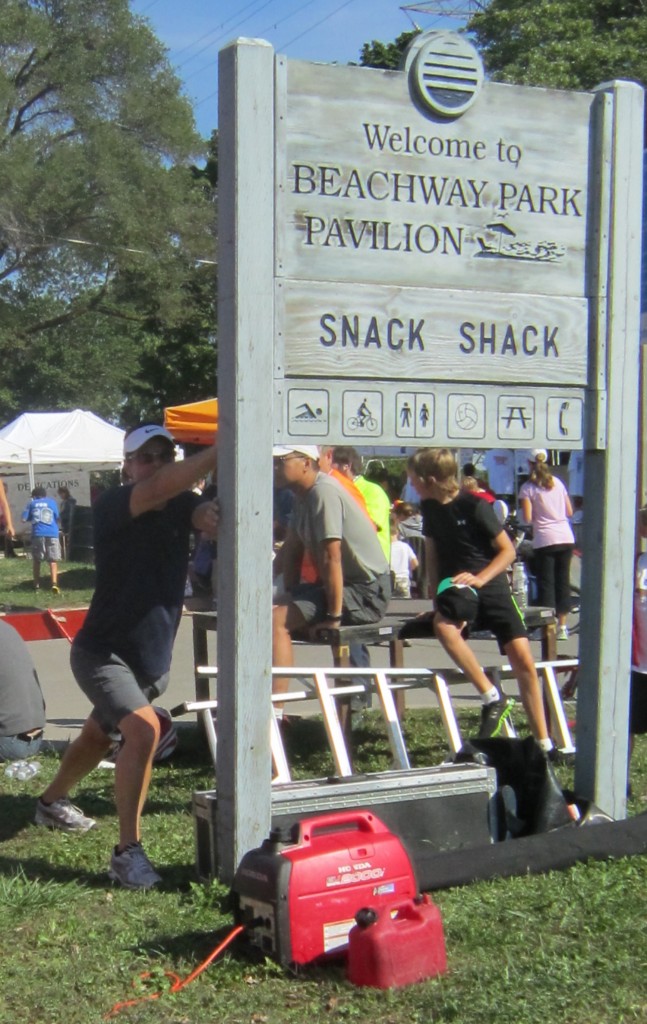 A good healthy stretch after a solid run.  Another good healthy stretch? Fox remains a prominent figure in Canadian folklore. His determination united the nation; people from all walks of life lent their support to his run and his memory inspires pride in all regions of the country. A 1999 national survey named him as Canada’s greatest hero, and he finished second to Tommy Douglas in the 2004 Canadian Broadcasting Corporation program The Greatest Canadian. Fox’s heroic status has been attributed to his image as an ordinary person attempting a remarkable and inspirational feat. Others have argued that Fox’s greatness derives from his audacious vision, his determined pursuit of his goal, his ability to overcome challenges such as his lack of experience and the very loneliness of his venture. As Fox’s advocate on The Greatest Canadian, media personality Sook-Yin Lee compared him to a classic hero, Phidippides, the runner who delivered the news of the Battle of Marathon before dying, and asserted that Fox “embodies the most cherished Canadian values: compassion, commitment, perseverance”. She highlighted the juxtaposition between his celebrity, brought about by the unforgettable image he created, and his rejection of the trappings of that celebrity.
Part 1 of a 4 part photo essay.
Part 2 of a 4 part photo essay.

 By Pepper Parr By Pepper Parr
BURLINGTON, ON September 17, 2012 After months of organizational work. Hours of committee meetings – the day had arrived. The weather was great. Just a little nippy at the start of the day when the Terry Fox Run team began to gather on site. A sign that the weather was going to be perfect.
With everyone in place; security checked out; the starting gate filled with air and the food and snack tables getting set up and the ladies getting into place at the registration tables – the day was getting close to starting.
The crowd was coming together – you could feel the buzz in the air.
Runners were lined up at the starting gate – but not quite yet. The exercise girls from Cedar Springs had to take them through a short warm up.
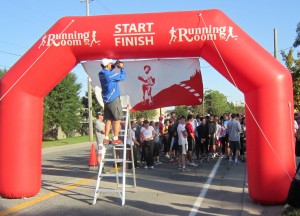 Starting gate is readied for the runners. And then they were off. Carrying on a 32 year tradition in Burlington that has seen more than $1.4 million raised. We will let you know what the amount raised was this year.
 The warm up ladies from Cedar Springs took the runners through a series of exercises before getting them through the start up gate. The tradition began back in 1980 when the first Terry Fox run took place and raised $4000 It`s been a steady grow upwards since then.
In 1980, with one leg having been amputated, Terry Fox embarked on a cross-Canada run to raise money and awareness for cancer research. Although the spread of his cancer eventually forced him to end his quest after 143 days and 5,373 kilometres (3,339 mi), and ultimately cost him his life, his efforts resulted in a lasting, worldwide legacy. The annual Terry Fox Run, has grown to involve millions of participants in over 60 countries and is now the world’s largest one-day fundraiser for cancer research; over $500 million has been raised in his name.
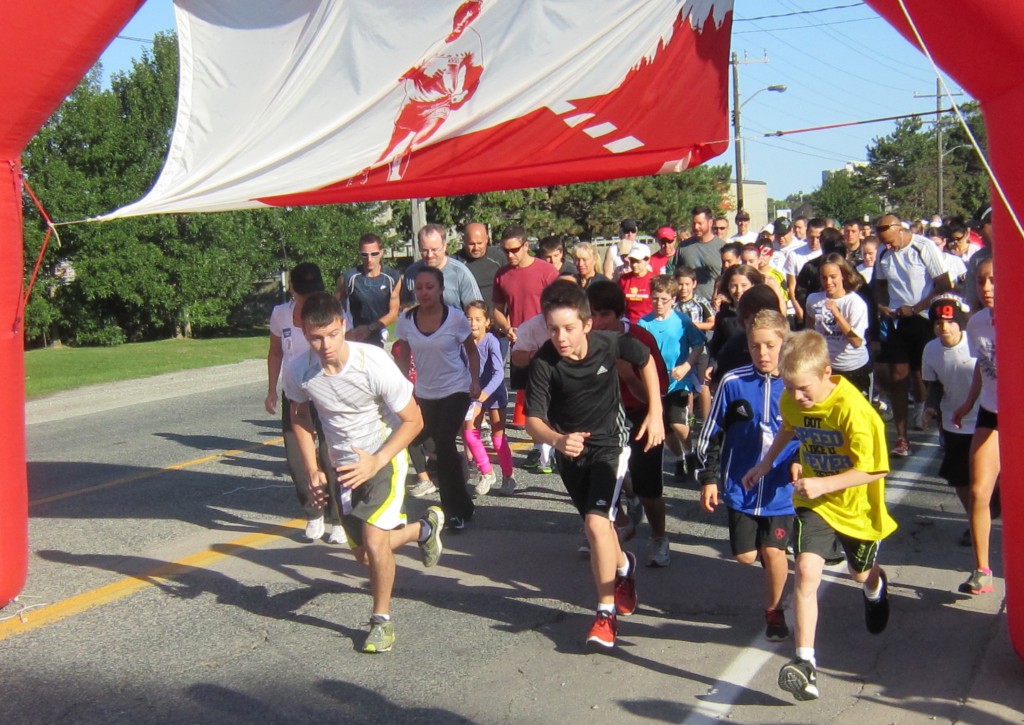 And they were off. There are parents out there who wonder why these lads don’t move quite as fast in getting ready for school or doing their homework. Look for the Tweeters getting out the word. Fox was a distance runner and basketball player for his Port Coquitlam, British Columbia, high school and Simon Fraser University. His right leg was amputated in 1977 after he was diagnosed with osteosarcoma, though he continued to run using an artificial leg. He also played wheelchair basketball in Vancouver, winning three national championships.
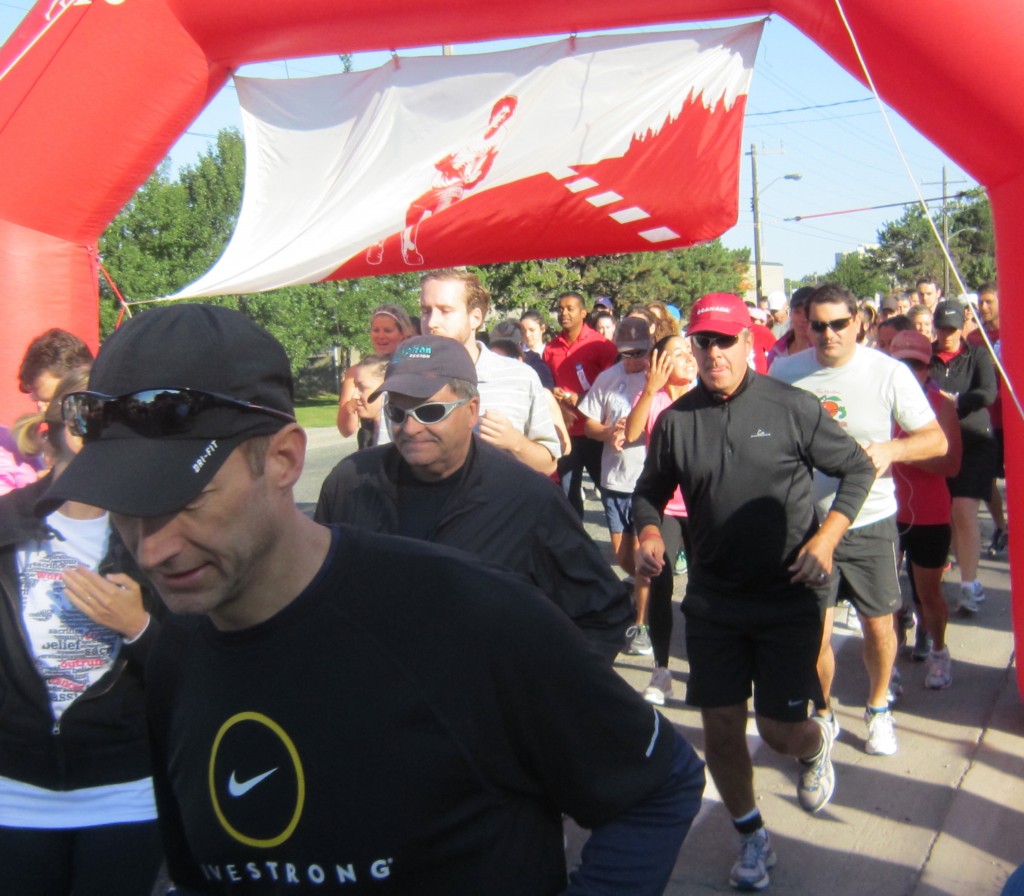 They just kept pouring through the starting gate. In 1980, he began the Marathon of Hope, a cross-country run to raise money for cancer research. Fox hoped to raise one dollar for each of Canada’s 24 million people. He began with little fanfare from St. John’s, Newfoundland, in April and ran the equivalent of a full marathon every day.
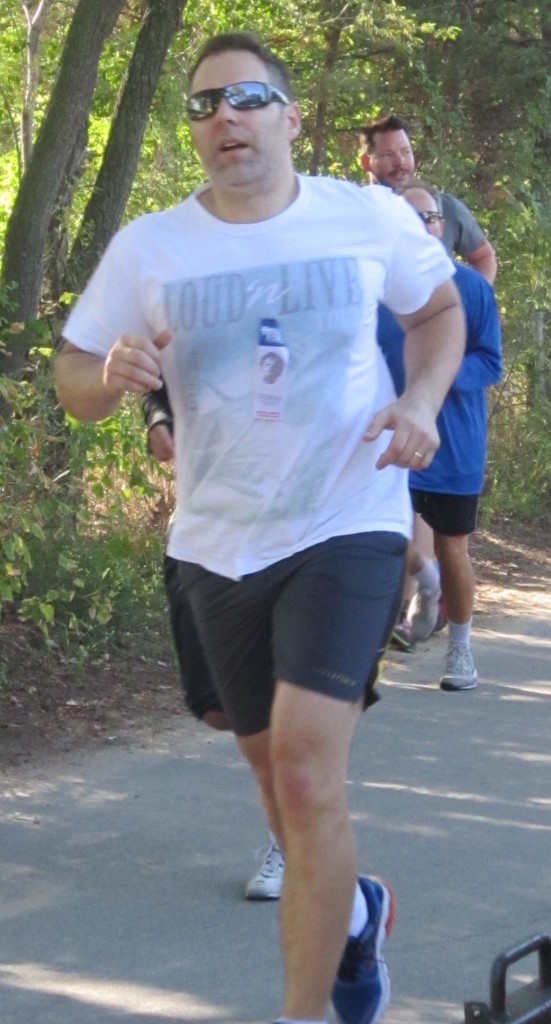 Good start and setting a nice pace. 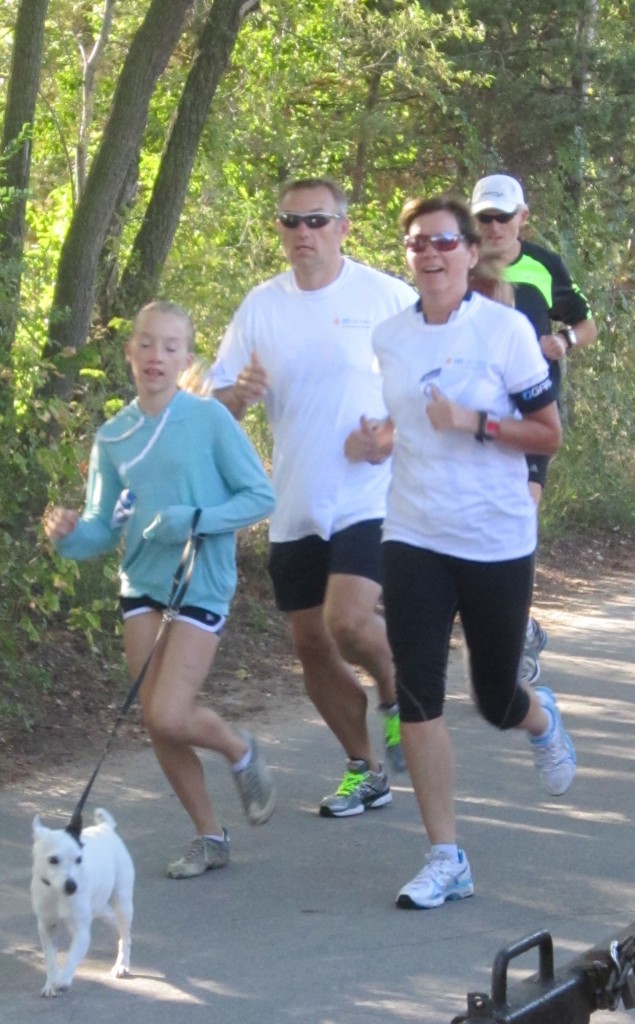 Pumping away on the backstretch going east from the canal on the way to the Waterfront Hotel. Nice 5k run Fox had become a national star by the time he reached Ontario; he made numerous public appearances with businessmen, athletes, and politicians in his efforts to raise money. He was forced to end his run outside of Thunder Bay when the cancer spread to his lungs. His hopes of overcoming the disease and completing his marathon ended when he died nine months later.
Fox was the youngest person ever named a Companion of the Order of Canada. He won the 1980 Lou Marsh Award as the nation’s top sportsman and was named Canada’s Newsmaker of the Year in both 1980 and 1981. Considered a national hero, he has had many buildings, roads and parks named in his honour across the country.
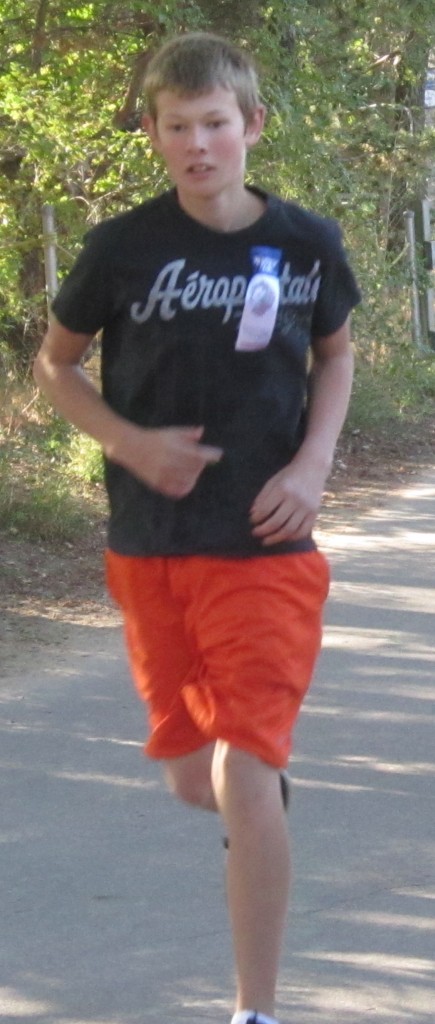 Doing the first half of the Burlington Terry Fox 5k run  These ladies are in the homestretch of the Terry Fox 5k run. 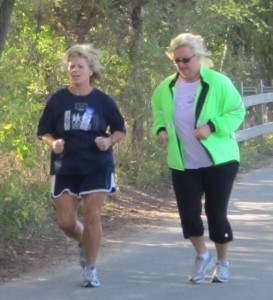 Each runner sets their own pace. The backstretch of the run is easy going and well shaded. Terry Fox was born in Winnipeg, Manitoba, to Rolland “Rolly” Fox and Betty Fox. Rolly was a switchman for the Canadian National Railway. Terry had an elder brother, Fred, a younger brother, Darrell and a younger sister, Judith. His family moved to Surrey, British Columbia, in 1966, then settled in Port Coquitlam in 1968. His parents were dedicated to their family, and his mother was especially protective of her children; it was through her that Fox developed his stubborn dedication to whatever task he committed to do. His father recalled that he was extremely competitive, noting that Terry hated to lose so much that he would continue at any activity until he succeeded.
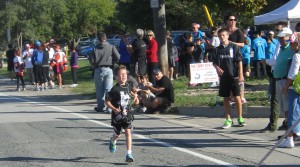 One of the younger runners enters the home stretch of the Terry Fox 5k run. Many his age did a second go around to make it a 10k run.
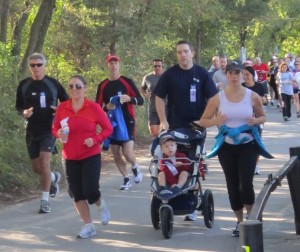 The runners working the back stretch of the 5k run. You name it and that kind of runner was out doing their part. He was an enthusiastic athlete, playing soccer, rugby and baseball as a child. His passion was for basketball and though he stood only five feet tall and was a poor player at the time, Fox sought to make his school team in grade eight.
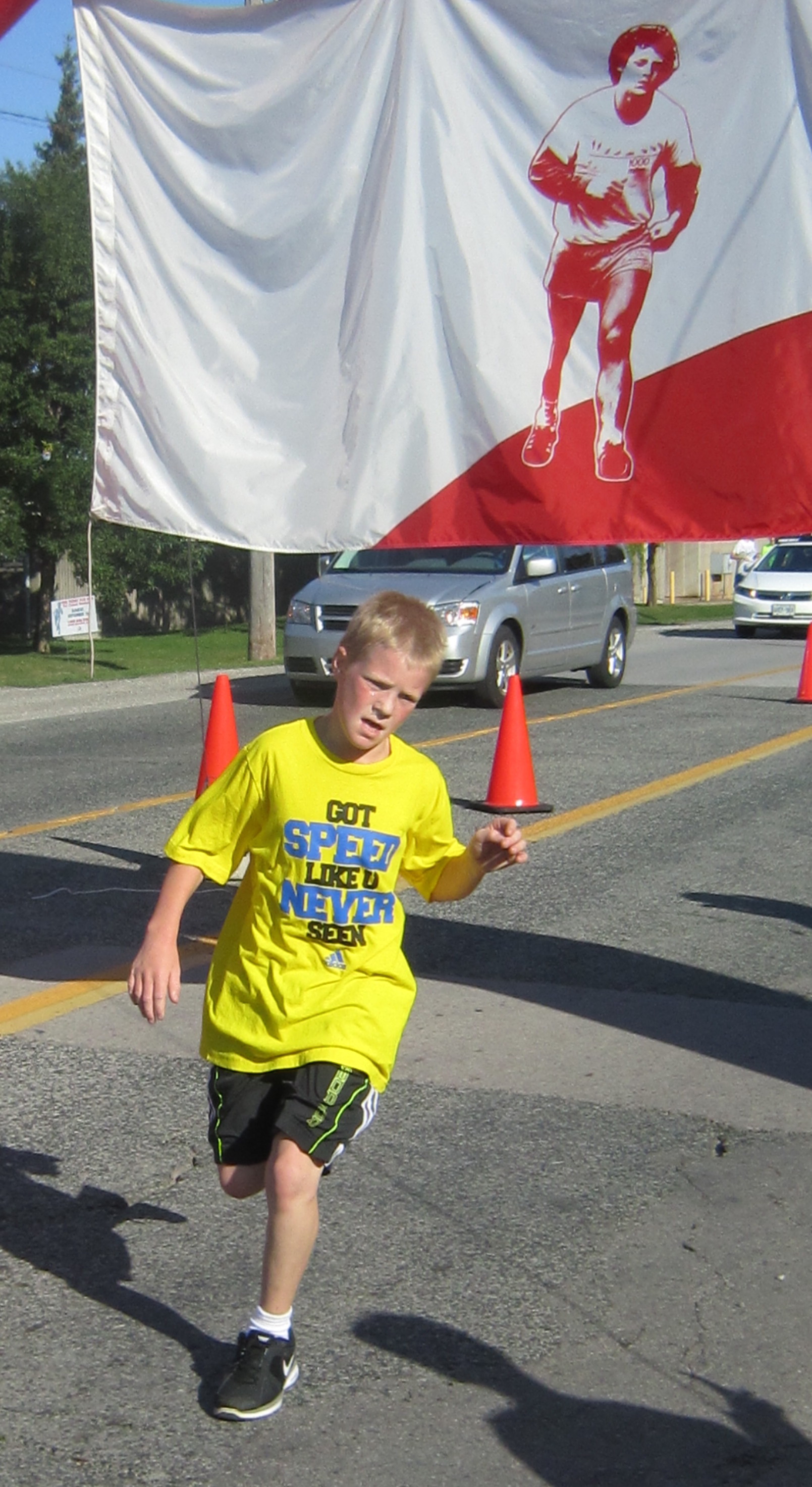 That finishing line looks good to everyone that sees it. Some used it as an opportunity to make a final dash. His physical education teacher and basketball coach at Mary Hill Junior High School felt he was better suited to be a distance runner and encouraged him to take up the sport. Fox had no desire for cross-country running, but took it up because he respected and wanted to please his coach.[6] He was determined to continue playing basketball, even if he was the last substitute on the team. Fox played only one minute in his grade eight season but dedicated his summers to improving his play. He became a regular player in grade nine and earned a starting position in grade ten. In grade 12, he won his high school’s athlete of the year award jointly with his best friend Doug Alward.
Though he was initially unsure if he wanted to go to university, Fox’s mother convinced him to enrol at Simon Fraser University, where he studied kinesiology as a stepping stone to becoming a physical education teacher. He tried out for the junior varsity basketball team, earning a spot ahead of more talented players due to his determination.
Part 1 of a four part photo essay on the Terry Fox Run

 By Pepper Parr By Pepper Parr
BURLINGTON, ON September 12, 2012 The first run was in 1980 when the city raised $4000 for the Terry Fox Research Foundation and a cure for cancer.
More than 1000 people were out on the pathways at Beachway Park and running through Spencer Smith Park.More than 100 volunteers helped people with massages, warm up exercises, giving directions and handing out glasses of water.
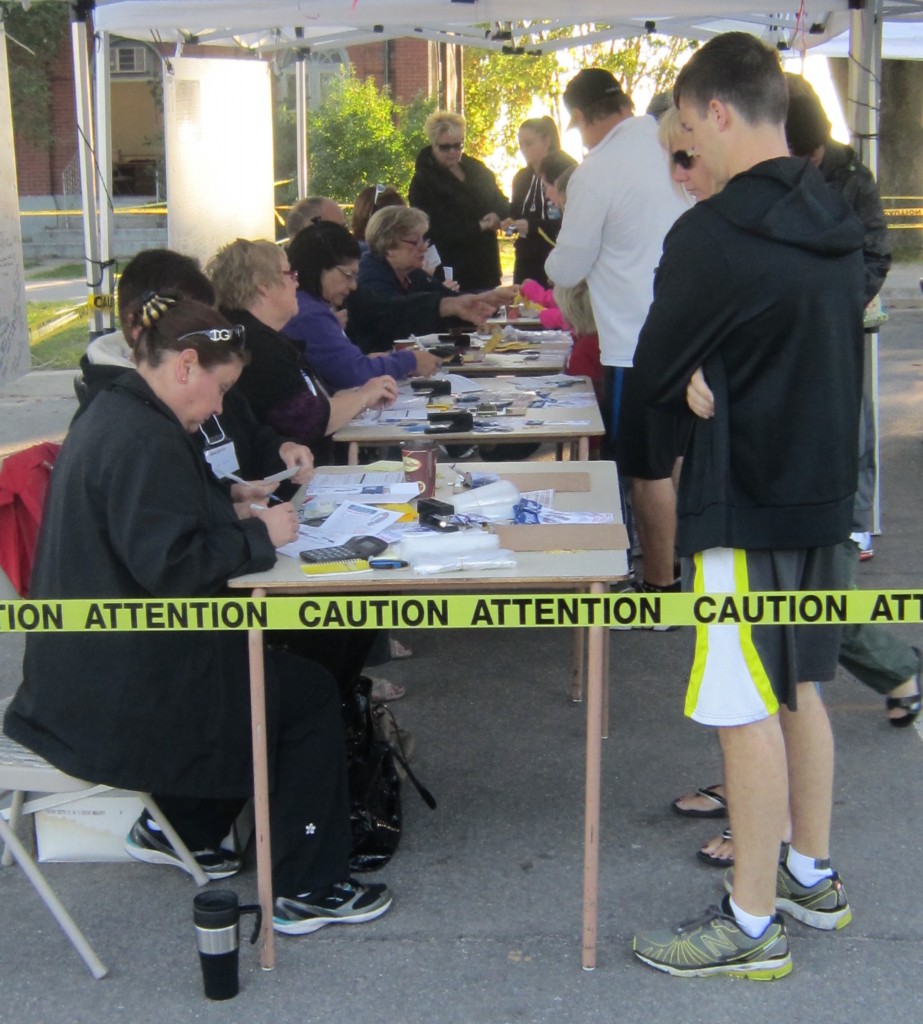 These are the ladies that collected the funds raised. One family came in with more than $1600 raised in their community. We will have the final count later in the week. We will know later in the week how much was raised in 2012. The total raised since 1980 in Burlington is now over $1.4 million.
Who would have thought that 32 years after Terry Fox had to abandon his run across the country using an artificial leg, that we would have hundreds of people coming out every year to run for a cause.
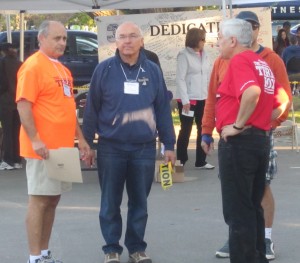 Don Carmichael, chair of the Terry Fox run in 2012, meets with part of his team to go over the final check ins before the event gets serious and the crowds begin to show up. Many, perhaps even most of the people who ran today were not alive when Terry Fox did his run. I heard about a one legged man declaring that he was going to run across the country when he dipped his artificial leg into the Atlantic ocean and headed west. It seemed like a bit of a stunt to me – I knew nothing about the man.
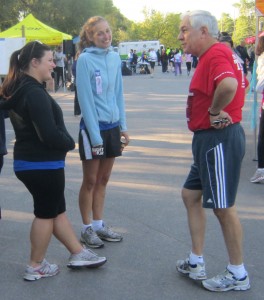 It was a little nippy in the morning, the kind of weather that helps the leaves turn colour and keeps people shivering just a bit. That changes when they begin their run. I was sitting in an office window watching Terry Fox run with that half limp, half trot of his as he headed south and into Nathan Phillips Square where more than 100,000 people were on hand to greet him. This was no stunt.
The fund raising drive, which hadn’t done all that well when it worked its way through the Maritimes and Quebec, picked up momentum as the national media picked up the story in Ontario and from that point it just took off. There were close to nightly news reports with a summary at the end of each week. The country was mesmerized by what this man was doing.
Eight years earlier Canada came together as a country when a Canadian Team beat the Russians in a closely fought hockey series. We had a sense of who we were after that and when Terry Fox caught our imaginations we had no trouble getting behind to help.
The country almost automatically made the project theirs and we’ve been doing that ever since we lost Terry Fox in 1981
He was born Terrance Stanley “Terry” Fox, on July 28, 1958 and was made a Member of the Order of Canada. There is much more to the Terry Fox story than this. Follow the Burlington event and the young man`s story.
Part 2 of the Terry Fox story and the Terry Fox run; a photo feature.
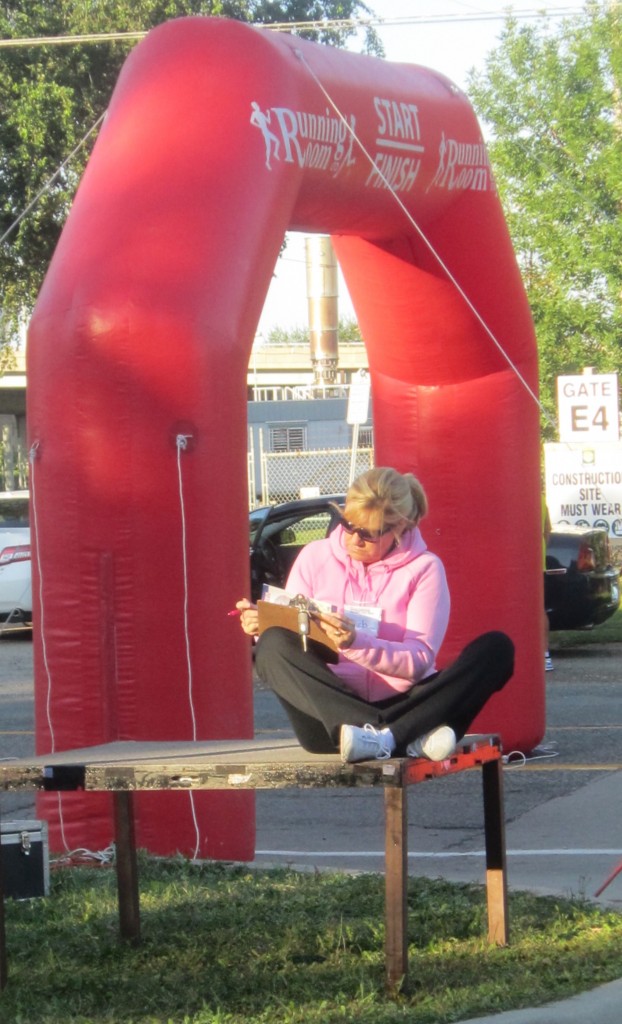 Deb Tymstra MC’d the event – her second year doing that job. Here she goes over her notes to prepare for an event that almost got out of hand when the Casey Cosgrove supporters were gathered to have pictures taken. That crowd was so large that it held up the Bikers and the Walkers who Tymstra wanted to get started. She managed the chaos. 
 Jane Goodall, renowned environmentalist will be in Burlington this week. Major coup for the BurlingtonGreen people and a day those attending her events will never forget. By Pepper Parr
BURLINGTON, ON September 17th, 2012 It is going to be a boffo week for the BurlingtonGreen crowd.
Dr. Jane Goodall is now in Canada; the BG’s are incredibly thrilled to have her first event presentation taking place right here in Burlington on Wednesday, September 19 !
Goodall will be sharing fascinating stories from the field, her reflections on global conservation and hope for the future of the planet to both a daytime audience of 700 Halton youth attending our annual “Imprints” Youth event followed by a sold out evening event also taking place at the Burlington Performing Arts Centre.
Not only can ticket holders look forward to this rare opportunity to get inspired by this world renowned environmentalist and UN Messenger of Peace, but there will also be a variety of great opportunities to learn more about how individuals can get involved with and support the important work of both the Jane Goodall Institute and BurlingtonGreen.
There will be a raffle for a chance to win a hugely popular paddleboard courtesy of Mountain Equipment Co-op. There will be book signing by Dr. Goodall, eco-displays and a fast paced but awesome Eco (silent)Auction too ! Click here for a sneak peak of the amazing auction packages that have been creatively and thoughtfully compiled that event participants will have an opportunity to bid on and take home!
The evening will be the perfect opportunity to celebrate some of our greenest achievers in Burlington following Dr. Goodall’s message of how individuals can truly make a difference. A worthy recipient from each of our award categories(individual, school, child, group, youth & business) will have the once-in-a-lifetime opportunity to join Dr. Goodall on stage to receive a special presentation – wow!
Clearly, the BurlingtonGreen people are excited – and they should be. This is a major achievement on their part. For those of you who didn’t manage to get tickets – stay tuned – we will tell you as much as we can about this really important visit.

 By Pepper Parr By Pepper Parr
BURLINGTON, ON September 13, 2012 We didn’t notice the appointment at first, the city has an awkward process of treating the names of people as confidential and making them public once they’ve been approved by Council. The sheet of paper with the names on it gets handed out at the end of a meeting and at times they don’t have copies for everyone at the media table. Whatever, I missed the list.
Burlington has a Committee that accepts nominations for Civic Recognition in a number of categories: Youth, the Arts, Senior of the year and Citizen of the year. The award has been given since 1965; one of the nicer events the city holds. The Civic Recognition Committee is comprised of 10 voting members, including: 6 citizens from the community, and four representatives from media and information agencies.
The event takes place, usually in May of each year . It is the one event that we do not cover as media; we buy our ticket and sit in the room as citizens recognizing honouring those who have served the city.
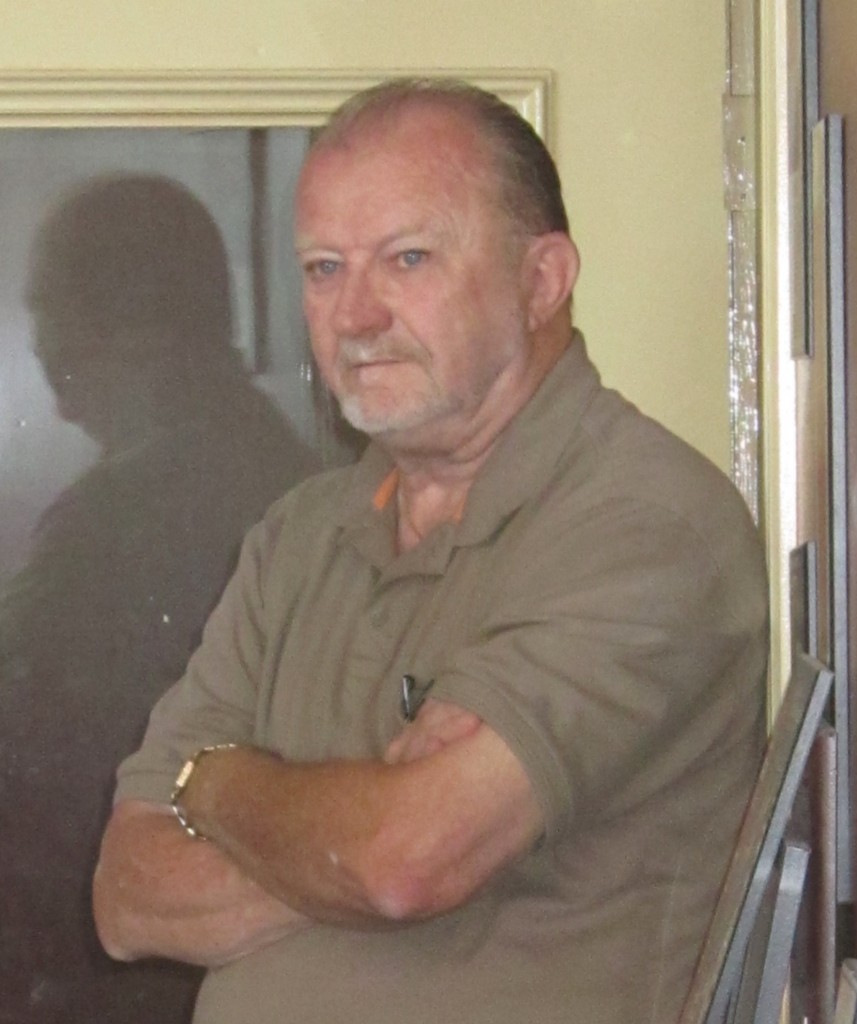 Keith Strong – recruited Jane McKenna as the Progressive Conservative candidate for Burlington then helped manage her winning campaign. Strong appears to have gotten McKenna on to the Citizen’s Recognition Award committee as well. This is a citizens event – it is not a political event. But this time out the people who were placed on the committee that reviews the submissions and chooses the winner in each category has a distinct political flavour to it – and that isn’t good for the process which was to recognize people who have made Burlington a better city no matter what their political stripe.
Most people have a political persuasion – but they are not “politicians”. They believe in an approach to government that is different than what others believe.
In October of 2010 the Clerks Department placed advertisements in the Update section of the Burlington Post seeking volunteers to fill vacancies on various local boards and citizen committees. In response to the advertisement, applications were received from a number of individuals expressing interest in the committees.
Part of the city’s Strategic Plan is to “engage citizens more effectively in City Council’s decision making processes”. Through citizen committees and boards, Burlington residents are provided the opportunity to offer Council advice and recommendations on various matters and/or organize activities that strengthen the community’s connection to the municipality.
The selection process for the Burlington Civic Recognition Committee was undertaken in February, 2011. The interview team for the committee was comprised of Committee Chair and its Past Chair. Staff from the Clerk’s Department also assisted with the process. The number of applicants this year did not exceed the number of available positions.
The interview team’s recommendation was based on the committee’s needs as well as the applicant’s knowledge of the role, relevant skills and experience, expressed dedication / commitment / time availability, and communication skills.
On February 24, 2011, the Council made the names for the Burlington Civic Recognition Committee public. Each person is to serve for a term that expires December 31, 2013 or until their successor is appointed, which suggests the appointee could be there for a very long time.
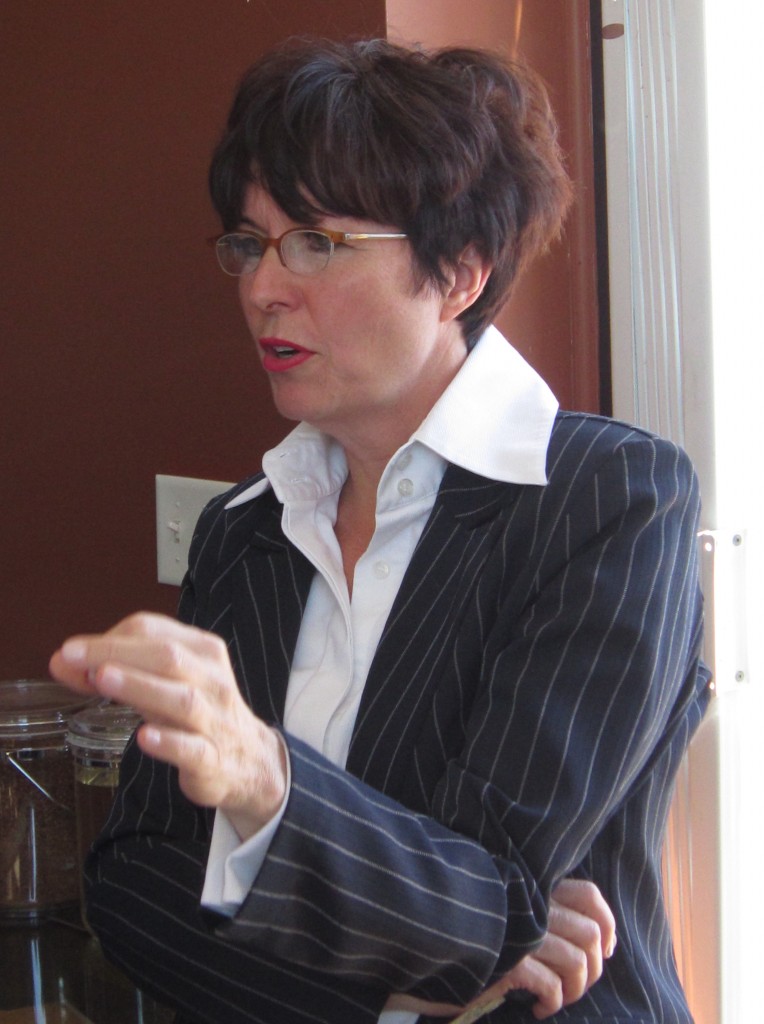 Does a sitting politician belong on a Citizen’s recognition committee? Jane McKenna now sits on the Board that chooses those who are to be recognized based on the nominations sent in. Lisa Boyko, Linda Cupido, Bob Hilton, Jane McKenna, Ann Coburn and Keith Strong were appointed.
Strong was the previous chair of the committee so he was re-appointed.
Jane McKenna was recruited as the Ontario Progressive Conservative candidate for Burlington by Keith Strong who was heavily involved in her campaign. McKenna went on to win the seat during the provincial election.
A number of people who are recognized for their contribution to the city go on to serve in a political capacity. That’s fine. But to put a sitting politician on a committee that is there to recognize others adds a political strain to a process that is there to recognize people for what they have done – not for which political party they favour.
Staff at city hall should have seen this one for what it is – political manipulation. We can do better than this.

 By Pepper Parr By Pepper Parr
BURLINGTON, ON September 17, 2012 If what football fans saw on Saturday at the Ivor Wynne Stadium in Hamilton is an example of what we might see during the 2012 United Way campaign – this is going to be one heck of an event.
During the game – which Hamilton won against the Edmonton Eskimos 51-8, the United Way campaign did their kick off and announced a target of $7 million of which $2 million is the Burlington portion.
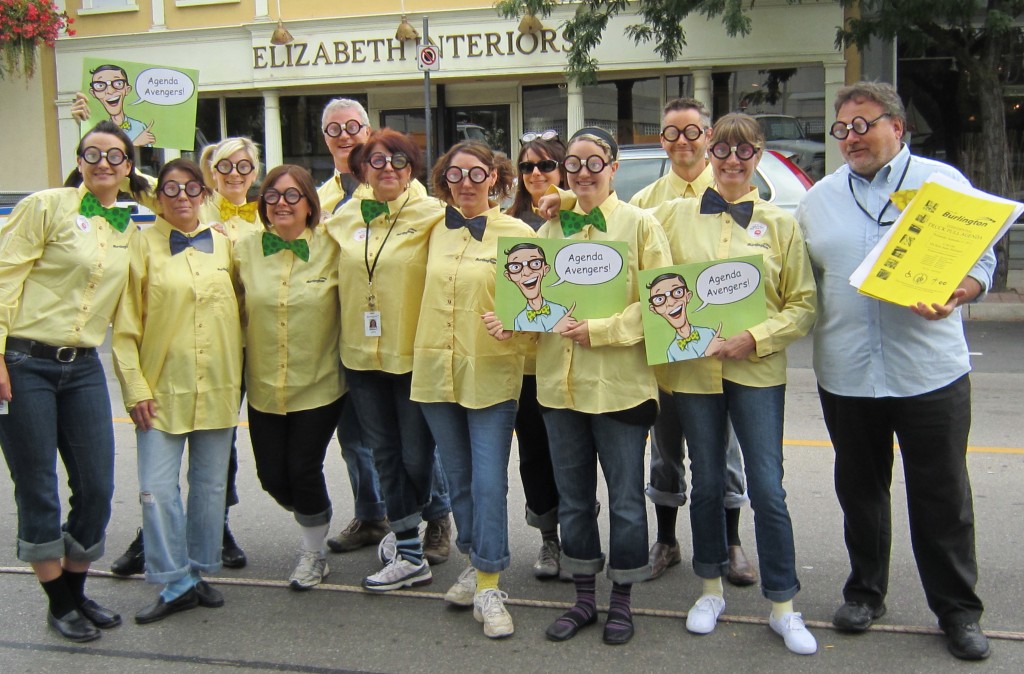 City of Burlington Clerk’s department did a great job last year during the United Way campaign drive. Interesting to see what they do this year. Burlington campaign has a $2 million target More than 20,000 fans took part in the kick off the 2012 United Way Campaign which got off to a roaring start as ArcelorMittal Dofasco President & CEO, Juergen Schachler and company Employee Donations Fund chair Larry Meyer announced a combined donation of $500,000. They presented a cheque on the field at halftime to Burlington Campaign Chair, Hon. Paddy Torsney and Hamilton Campaign Chair, Dr. Nick Bontis.
ArcelorMittal Dofasco extended an additional challenge to the community to step up for the United Way. The company and employees announced they would match an additional $50,000 for money raised through new workplace campaigns, new leadership donations of $1,000 or more, leadership donations that increase by a minimum of 10%, or donations that increase to the $1,000 level (the increased amount). The program is designed to inspire the people of Hamilton and Burlington to help build community strength by donating to the United Way.
With more than $1,134,732 already raised via corporate and individual contributions, the community has already begun to show their support for United Way. Of that total, the United Way family, (Board of Directors, Campaign Cabinets and staff) contributed $88,359.
 Nick Bontis is chair of the United Way Campaign for Burlington and Greater Hamilton. He teaches at McMaster where his mile a minute delivery dazzles his students. Bontis dazzled an Economic Development luncheon earlier this year. Nick Bontis of McMaster University fame found himself having to hand off quite a bit of the kickoff event to Paddy Torsney who is heading up the Burlington part of the campaign. Bontis did some serious damage to one leg during a soccer game. Don’t think that’s what they intended by “kick off”.
Torsney, who had never kicked a football in her life, got some tutoring and did a more than credible job at “getting some air” under the ball. For the United Way campaign team they too feel there is some air underneath their efforts.
“We have a lot of younger people involved in the campaign this year”, said Torsney and ” we are going to put part of our focus on those smaller corporations in Burlington that don’t have an employee program”.
The Burlington team has two families involved in the campaign who both have twins – “they obviously now know how to manage their time – they will do great work for us” said Torsney.
Brian Ferguson of VM Ware is onboard as is Gayle Cruikshank of Food for Thought. Kim Phillips, a city of Burlington General Manager is handling the campaign at city hall as well as the government sector.
Torsney, the one time Member of Parliament for Burlington wants to grow the $2 million target for Burlington by seeking additional leadership donours and getting into companies that currently don’t have a program that allows their staff to donate through a payroll program.
Deb Pickfield of ThinkSpot is heading up a unique “mystery night” event that will appeal to this community.
“Community investment is a longstanding tradition for our company and our employees,” says Juergen Schachler. “We know that continuing to build the strength of Hamilton and Burlington is an important part of being a business leader. For 100 years, the company and its employees have been a key pillar in the community. With our additional challenge, we are inviting others to step up to help the United Way as they continue to create change in our communities”.
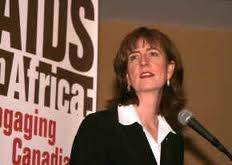 Paddy Torsney heads up the Burlington side of the United Way campaign for 2012. Expect a call from her – soon. Over 222,000 residents rely on United Way programs and services. In the weeks ahead we will tell you more about the people and the services that are delivered because the donations are made.
United Way of Burlington and Greater Hamilton works to effect long-term changes that make a measurable difference in the community. When you donate to the United Way you are having a direct impact and are changing the lives of those in need in our community.

 By Pepper Parr By Pepper Parr
BURLINGTON, ON September 13, 2012 Two Spencer’s Restaurant Chef’s will duel it out at the Farmer’s Market on Friday. Chris Hayworth and Andrew McLeod will shop from the different vendors at the market and then cook up a meal, using what they bought at the market – all organic, that visitors to the market can sample at the tables Barry Imber, the driving force behind the idea of an organic market in downtown Burlington, plans to set out for people to use.
 It’s not a crowded market but it does have a consistent flow of traffic during the two hours it is open. Great produce, pork offerings are very good and each week someone else shows up with a new product. We got great sour-dough there last week. 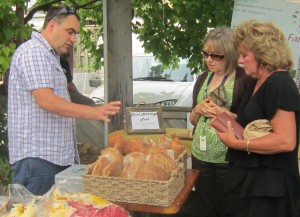 Fresh bread – straight from the ovens – but you had to get there while the basket still had something in it. The Farmer’s Market, located off John Street just north of James back in behind Centro Gardens, focuses on local organically grown produce, meat and dairy.
It started up during the early summer and while traffic has not been overwhelming, it is consistent with people drifting in and out during the noon to 2:00 pm window they are open.
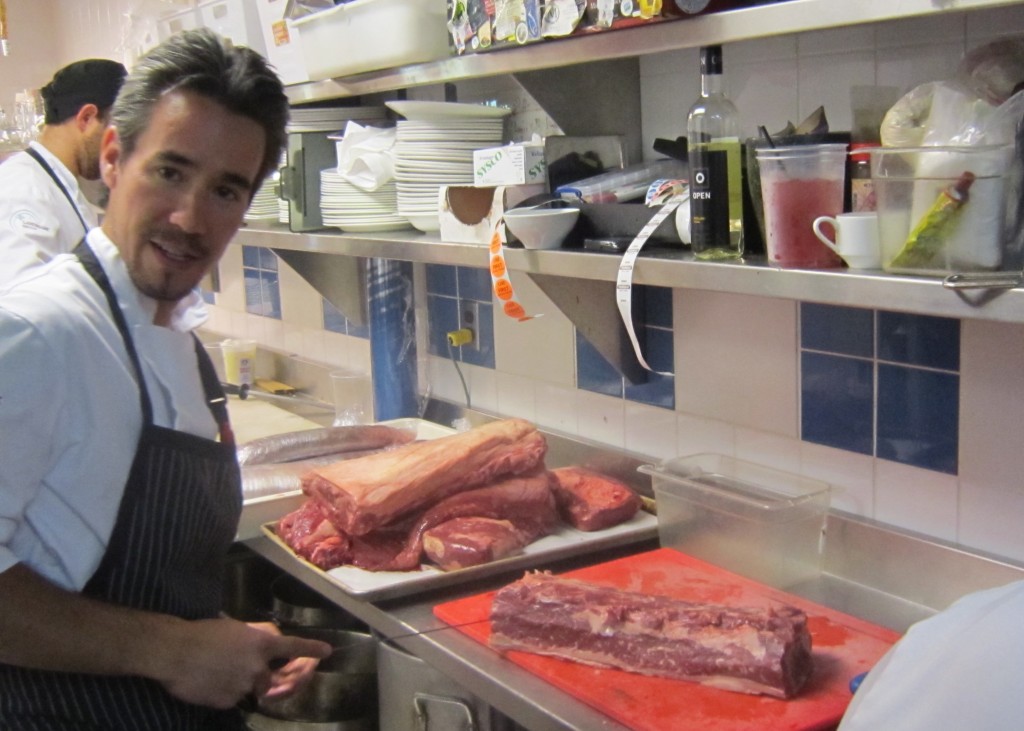 Chef Chris Hayworth shows how he will use his knife at the Chef’s Duel scheduled for Friday just after noon at the Farmer’s All Organic market on John Street. Imber decided to give the location a bit of a promotional boost and challenged the two Spencer’s chef’s to duel it out over their stoves using just the produce available at the market.
 Candace Ivezich, sales agent with LeavoyRowe, purveyors of fine meats just might be Chef Hayworth’s secret weapon. Hayworth plans to play it by ear and see what is on sale- and then use his creative imagination to pull together a meal he is sure will win the day for him.
Hayworth is a full range chef but he tends to like to focus on the appetizer part of the menu – and where he can he goes local.
Could be fun – certainly will be tasty.
Chef Hayworth has a bit of an advantage – he has a supplier that wants him to win; that might tip the scales.
At press time we had not heard from Chef McLeod – maybe he has decided to concede and won’t show.
You be the judge – and see what they serve up.

 REVISED REVISED
By Pepper Parr
BURLINGTON, ON September 13, 2012 Earlier this week the Halton Regional Police got to play with their newest toy – what you and I would call a model airplane with a small engine in it. Others might call the thing a drone. The police called it a UAV – Unmanned Aerial Vehicle which they use to identify illegal outdoor marijuana grow locations.
Members of the Drug and Morality Unit, Guns and Gangs Unit assisted by members of the Forensic Identification Services conducted an outdoor marihuana eradication initiative and found 744 plants in north Milton and Halton Hills. The police estimated street value of the cannabis marihuana seized at $744,000, which would value each plant at $1000 Someone is fibbing here.
Shortly after publishing the story we got a note from an Ontario based company who pointed out to us that they made the UAV. They said: “Reaching out to draw your attention to the fact that the small unmanned aerial vehicle (UAV) used by Halton police was actually a Canadian-made local product – the Aeryon Scout sUAS – rather than US product shown in the story.”
We used the only picture we could find to illustrate the story we ran.
Odd that the Halton Regional Police made no mention that the product they use was made in the province.
 The Aeryon Scout, made by a Waterloo firm that is a recognized leader in the development and commercialization of small Unmanned Aerial Vehicle (UAV) Aeryon Labs Inc. was founded in 2007 and is located in Waterloo, Ontario, part of Canada’s Technology Triangle. A recognized leader in the development and commercialization of small Unmanned Aerial Vehicle (UAV) systems, Aeryon Labs is the trusted partner of civil and military customers, resellers, other commercial business partners around the globe.
The Aeryon team has developed the Aeryon Scout, an easy-to-use, battery powered, unmanned aerial intelligence gathering system. The Scout can be flown by anyone with only a few minutes of training due to its simple point-and-click navigation and camera control systems. Fully stabilized and weather-sealed, the Scout can fly anywhere, anytime in the most demanding weather and wind conditions – when other systems simply cannot fly.
The Aeryon labs team brings together engineers with experience from a broad range of fields, including computer and electrical engineering, video processing, digital video compression, telecommunications, mechanical and mechatronic system design and software development. Our team has the strength of numerous post-graduate degrees in robotics and image compression and brings significant experience from leading global organizations such as LSI, Cisco, Raytheon, RIM and L3-Wescam.
The Aeryon Scout was used by the Libyan Free Forces during the removal of the Gadhafi government.
 Investigators remind the public to utilize Crime Stoppers to report any illegal drug, gang or gun activity at 1 800 222-TIPS(8477), through the web at www.haltoncrimestoppers.com or by texting “Tip201” with your message to 274637(crimes). Investigators remind the public to utilize Crime Stoppers to report any illegal drug, gang or gun activity at 1 800 222-TIPS(8477), through the web at www.haltoncrimestoppers.com or by texting “Tip201” with your message to 274637(crimes).

 By Pepper Parr By Pepper Parr
BURLINGTON, ON September 12, 2012 There they were, out on the field, grunting, running, stretching their limbs – more than thirty of them practicing as the Bateman High School Senior Football team.
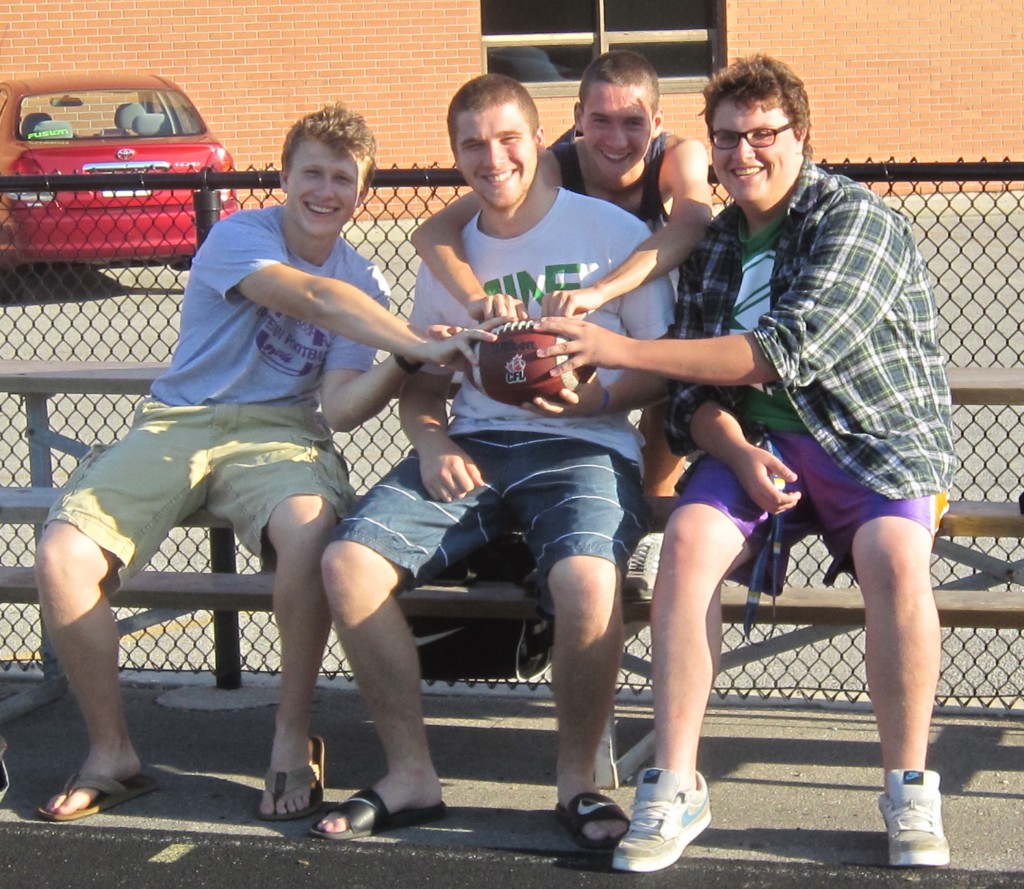 The protesting team – from the left: John Phelps, Chad Doan, Kennedy Dyet and Chris Bishop. When the football players learned their team had been scrubbed from the football schedule they took to the streets in protest. They made their point and the football team is back on the field. Now they might have to deal with a teacher work stoppage. They had to protest to get there – but after a part of a day out on the street waving signs and seeking support for their team – they were back in business.
No one remembers when there was a demonstration by students at Bateman before and it took courage to make the decision to protest when they learned that their wasn’t going to be a Senior Bateman football team on the field for 2012.
Chris North sent an email to Our Burlington – we ran with his letter and followed up with a visit to the school to see how the protest and demonstration went. While there, we saw some student behavior that was great, we saw kids talking in groups the way students around the world talk in groups and we saw students that were behaving – let’s be blunt about this – it was just plain dumb behaviour. We certainly heard about that from more than 45 students and the parents of students. That’s all part of an interactive process where people get to say what they think. We will comment on how that went later in the week.
This piece is about the football team – the guys that decided they weren’t prepared to see their team disappear from the roster. Chris Bishop led the group that was made up of Chad Doan, Kennedy Dyet and John Phelps. All are back at Bateman doing an additional year to upgrade their marks. All have clear plans to attend university with a pretty good idea of what it is they want to study.
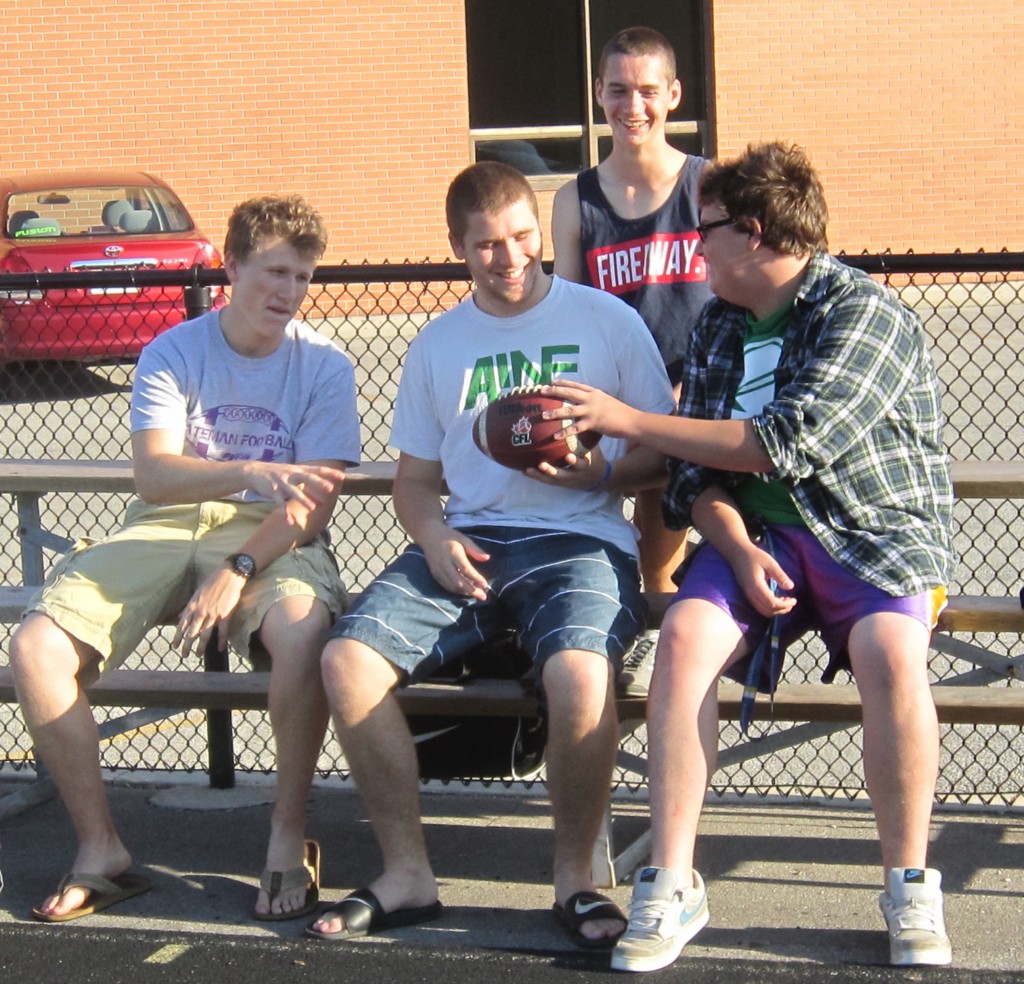 Four high school football players who felt their team was wronged and took to the streets in protest. They made their point and are now back on the football field. Gotta be at least eight proud parents out there. From the left: John Phelps, Chad Doan, Kennedy Dyet and Chris Bishop. Doan wants to study psychology. “I’m interested in the way people behave and want to learn more about that”, said Doan, which led to questions about how the school administration behaved when they decided to shut down the team.
Chris Bishop thinks he wants to study criminology and maybe look into law. Another student wants to study sports management.
The students felt they were told it would be “impossible” for a senior team to be put together and so they were scrubbed from the schedule.
“They had a mind-set and didn’t think we could field a team” said Dyet who coaches a team in the Burlington Minor Football Association.
These four young men didn’t see it that way. They believed they could mount a team but, just as important to them was the rule that would mean there would be no team playing the following year if they did not mount a team this year – and these four young men didn’t want to see that happen to those that would follow them.
Kennedy Dyet wonders why they had to protest. “We were told there was nothing they could do for us” but once the protest was underway the principal of the school met with the football players and asked how he could help.
It looks as if the Phys-ed people had given up on the students and pulled the team from the schedule. The students say they weren’t told the team was being pulled. There was clearly a lot of energy and enthusiasm on the part of at least some members of the team, which when identified, moved the administration to get behind the students. Now the football players have to get the school behind the team and begin winning some games.
On Tuesday evening there were 29 seniors out on the field – huffing and puffing through the exercises. It looked like a good workout from the side lines.
The Bateman Seniors are a Tier 3 team – they want to move to at least Tier 2 and see Pearson and Aldershot as the schools they have to beat. “We’ve got six to seven regular games in the season” explained Dyet “and then the semi-finals.
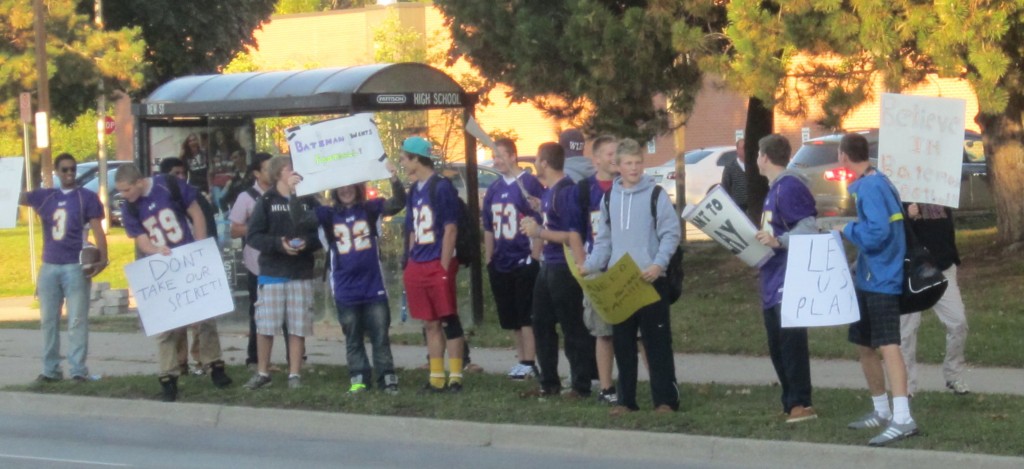 Football team protests the scrubbing of their team from the schedule. Administration changes its mind – team out practicing – next they have to win some games. Chris Bishop feels the support they need is now there for them within the administration but also feels that it wasn’t there for them before they hit the streets with their signs. “The principal did meet with us at the Bistro and asked us what it was we wanted and we told him we wanted our team on the field. “Mr. Heffernan said he would do everything he could to help us – that’s all we wanted” said Bishop.
Kennedy Dyet added that the volleyball players are battling for a program “and we think what we’ve done will help them get what they feel they deserve.”
“We had faith that we could make out point” added Dyet “and now we have to do the hard work.”
The players commented on the new coaching staff they have. “These guys have great history commented” commented Chad, “one of our coaches was with Team Canada.”
Is there a problem with the commitment level on the part of the phys-ed staff and the school administration at Bateman? May have been. Had they given up on their students and as Kennedy put it, brought a “mind set” to the table that prevented them from seeing what the students wanted and what they were prepared to do.
Will the “no strike” legislation the provincial government has passed impact this football team that has shown it wants to be out on the field playing the game. Are teacher politics going to get in the way of the educational process the way it did in when the Mike Harris government was battling the teachers?
The young men we talked to were polite, focused, left me feeling there was a clear sense of purpose and an objective they had thought through. I came away with the feeling that there are eight proud parents out there somewhere.
The task now is to develop and condition their team and support them with enthusiasm that provides the energy and that extra bit of “make it happen” that a cheering crowd can give a team. All four young men know exactly what a cheering audience can do for athletes.
Go Wild!

 By Pepper Parr By Pepper Parr
BURLINGTON, ON September 13, 2012 Burlington’s Mayor Rick Goldring seems to have taken that insurance tag line – Freedom 55 – to heart. Now that he is 55 years of age he has decided to become a member of the Senior’s Centre. This man recognizes a bargain when he sees one – coffee at the centre is $1 a cup.
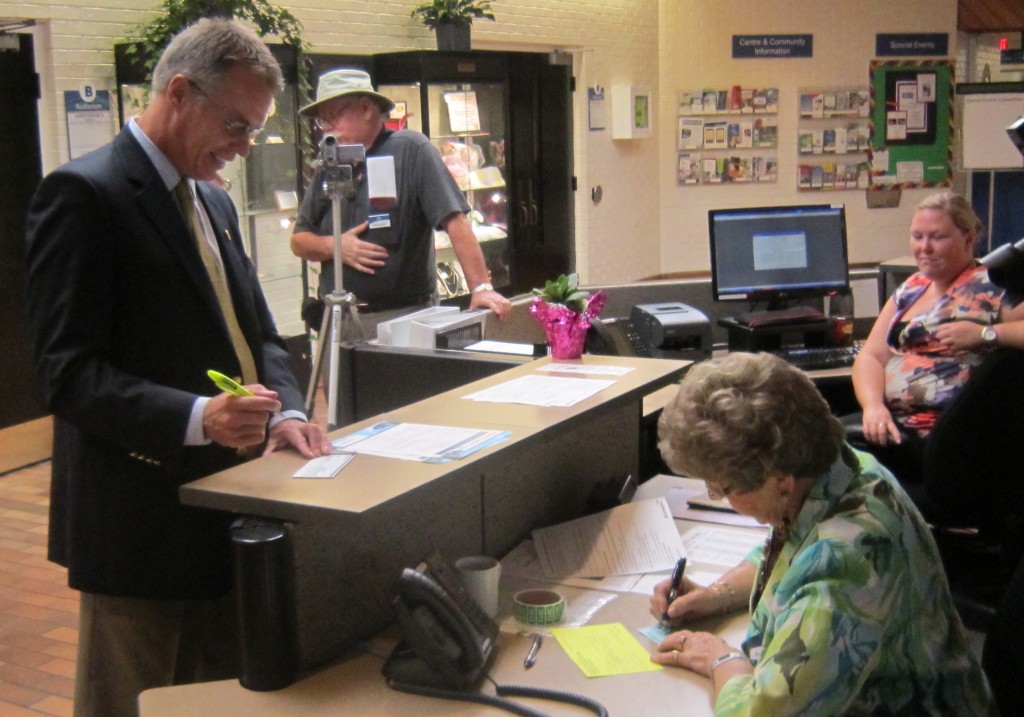 Mayor Rick Goldring has his membership application processed at the Seniors’ Centre – filling another of his campaign promises. The Mayor chatted with the Heather Pilling, supervisor of Adult and Senior programming for the city and the lady responsible for the operation of the Seniors’ Centre. Newly appointed Ms Pilling appears to have passed the first acid test with what is a tough crowd to keep happy. “She’s as different as chalk is from cheese when you compare her with the other person who was here” commented Joe Veitch, who was in the process of filming the Mayor’s membership event at the Centre.
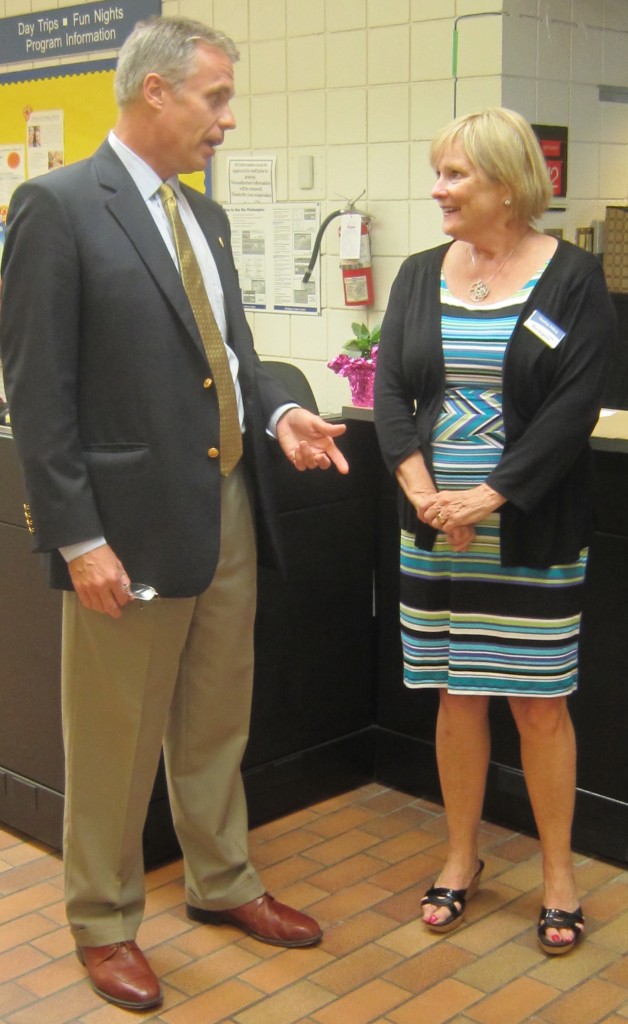 Heather Pilling the newly appointed Supervisor of Adult and Seniors programming for the city, welcomes Mayor Goldring as a new member. Pilling will be the city’s eyes for a constituency that can get cranky at times and very vocal. Veitch is one of the people taking part in the WNEB Buffalo television station’s plans for an Our Town segment. Joe Veitch as a film producer/director – imagine that?
Becoming a member of the Senior’s Centre was a campaign promise made by the Mayor – he made the promise a second time – the day the city gave the Seniors’ Centre more money than one could carry in a wheel barrow. On that occasion the city basically bought the support of the seniors with money to pay outstanding taxes, money to pay for their incorporation and money to cover the insurance they will need. Those seniors will be in for a bit of a surprise when they realize they aren’t going to get gifts like that every year – 2014, an election year might be the exception.
With his 55th year upon him and a membership card in his pocket the Mayor crossed the street to the Band shell park and mingled with the seniors out enjoying their annual Brown Bag picnic.
Then he did what every politician has to do – he made a speech – a very short one. This man knows how to read his audience.
While everyone is vaguely aware that we are an ageing society it is only when the fact is laid out in raw numbers that the point is really made. 17% of Burlington’s population is over 65 and 45% of the population is over 45 – according to 2011 census data. 46% of the seniors in Halton live in Burlington, according to 2006 census data.
We can see where this is going. If the trend continues we will become a city with an older population, albeit one with high disposable income if the number of high end retirement homes going up. There are two under current construction that are more than six stories high – more like warehouses for older people. And they are not cheap.
The handi-van showed at the picnic site frequently and there was a decent flow of taxis which suggests how many seniors will be getting around town.
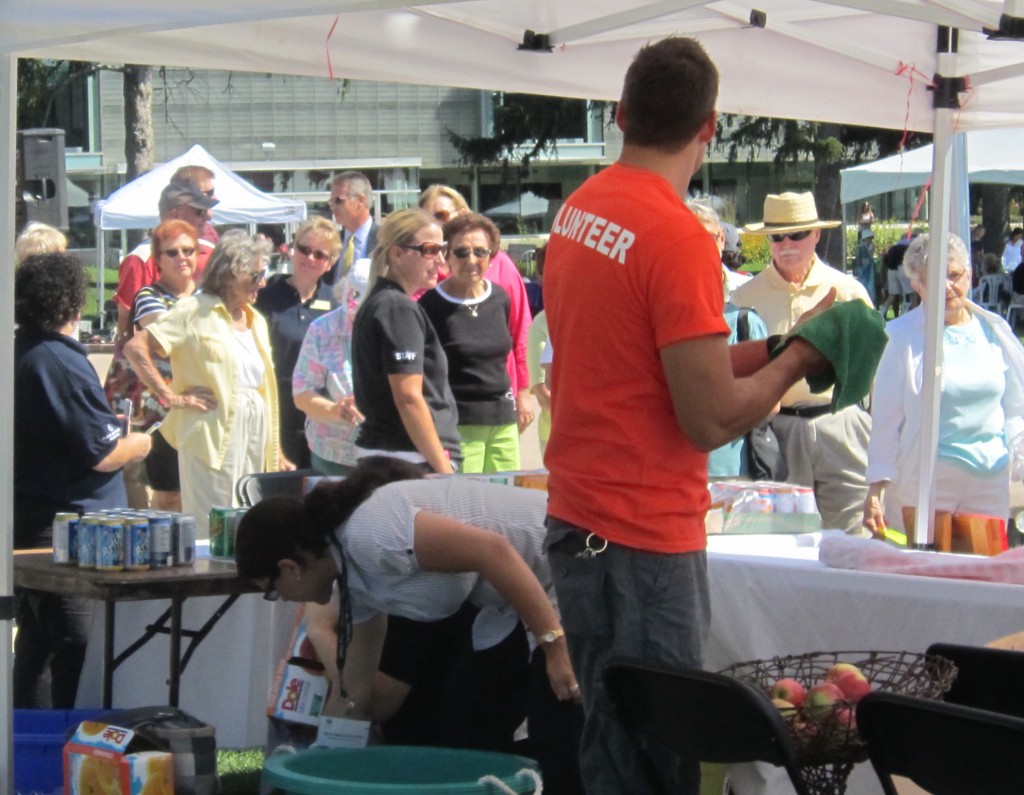 Lining up for a Brown Bag lunch – annual Seniors’ Centre event held at Central Park this year. Last year the LaSalle Park event got rained out. For the Mayor it was a good day. As he walked into the park around the band shell one constituent called out: “Hello there Mayor Rick”. He’s got that vote.
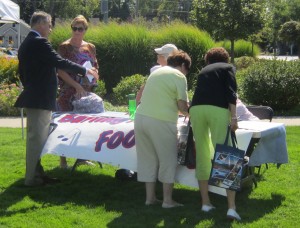 Mayor Goldring talks about seniors and their issues with a community representative. The Brown Bag picnic, an annual event, is for a demographic that is also a market. Vendors with various products and services took part in the event. Keeping a constituency happy is however just part of the job – the Mayor also has to look longer term and get his community thinking about what we are going to do in terms of serving this aging population. On October 17th, the Mayor has invited Dr. Samir K. Sinha MD, DPhil, FRCPC Director of Geriatrics Mount Sinai and the University Health Network Hospitals, Assistant Professor of Medicine University of Toronto and the Johns Hopkins University School of Medicine and a Medical Advisor to the Toronto Central Community Care Access Centre.
He will be talking about how communities serve their ageing population. October 17th at the Performing Arts Centre. In the past these events have been close to full – if this matters to you – get there early.

 By Pepper Parr By Pepper Parr
BURLINGTON, ON September 11, 2012 Mayor Rick Goldring finally gets his Cabaret off the planning Boards and onto the stage of the Burlington Performing Arts centre where both the Arrogant Worms and The Lighthouse will take to the stage.
The day before the Mayor does his thing Burlington’s Gordie Tapp of Hee Haw fame is going to MC A Laugh a Minute — The Mike Wallace Roast.
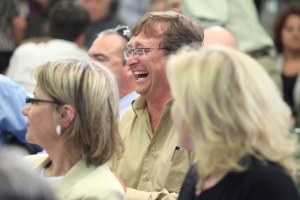 Wallace does know how to laugh and take a joke – expect him to be at his funniest while his colleagues roast him royally – with Gordie Tapp leading the crowd – it will be a riot. The Wallace event, taking place Friday September 28, is sponsored by the Burlington Federal Conservative Riding Association. The guest list of roasters includes Halton Riding Conservative MP Lisa Raitt and Michael Chong, Tory MP for Wellington-Halton Hills.
Cocktails are at 6 p.m. with dinner at 7 p.m.
Mayor Goldring came up with the Gala idea some time ago and had to shift the dates but he is now ready to have the curtains of the Performing Arts Centre stage pulled back for an evening of entertainment, receptions and both live and silent auctions. This might be your chance to get one of the Mayor’s election signs.
A variety show featuring special guests Lighthouse and The Arrogant Worms, along with some very talented local artists will make up what the Mayor says is “ sure to be an extraordinary evening”.
Lighthouse is a Canadian band whose music includes elements of rock, jazz, classical, and swing. They won Juno Awards for Best Canadian Group of the year in 1972, 1973 and 1974. Some of their hits include One Fine Morning, Sunny Days, Pretty Lady and Can You Feel It.
 Featured performers at the Mayor’s Cabaret – the Arrogant Worms bring their music to the Performing Arts Centre. The Arrogant Worms were formed in Kingston, Ontario and consist of Mike McCormick, Chris Patterson and Trevor Strong. Their musical comedy act has been played on three continents to crowds as large as 100,000 and they have sold more than 150,000 copies of their 12 albums. The Arrogant Worms have been described as “too much fun for their own good.”
Funds raised from this event will benefit The Burlington Performing Arts Centre. Tickets, $150 with a tax receipt issued for $100 are on sale now at The Burlington Performing Arts Centre box office.
Dress code is polished casual; that’s a new one. In addition to the show, there will be pre- and post-show receptions and silent and live auctions.

 By Pepper Parr By Pepper Parr
BURLINGTON, ON September 11, 2012 The registration tables will be set up, the weather should be fine and the 1000 people expected to take part in the 2012 Terry Fox run will do what Burlingtonians have been doing for 30 years – running to honour both the memory and achievement of a remarkable young Canadian.
The organizers of the event think it is probably the longest continuously held run in Burlington
They are expecting about 1000 runners/walkers/joggers/bikers/skateboarders this year for the non-competitive run, no entry fee, no minimum pledge event. They just want people to show up and run.
 Terry Fox was one of the most remarkable young Canadians this country has ever seen. His example, his courage and his contribution is one that every young person in our high schools can learn from. The event is always held on the third Sunday in September. Registration begins at 8am at the Comfort Station on Lakeshore road
5 and 10 KM runners go off at 9:00 am; Family run begins at 10:00 am. Pets welcome (there are water bowls and dog treats), roller blades, strollers, bikes, strollers – all are welcome.
The event has a family atmosphere with some fitness instructors from Cedars Springs leading warm up exercises.
There will be a Master of Ceremonies from Cogeco TV as well as a disc jockey pumping out tunes. Add in face painting, balloons and water stations along the route and its hard to go wrong with this one..
There are more than 100 volunteers that make this happen.
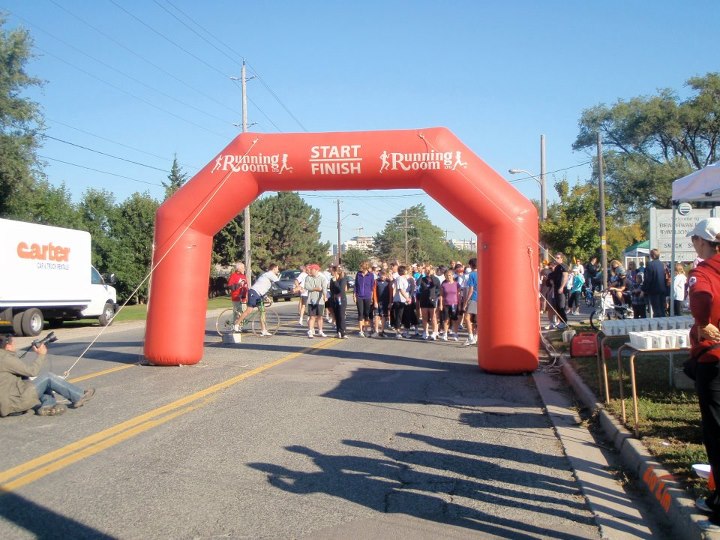 Starting gate – the point at which you begin your 5 or 10 k Terry Fox run The route is one of the most beautiful anywhere in the province. It starts at Beachway Park pavilion behind Joseph Brant hospital, along the waterfront through Spencer Smith Park to the Waterfront Hotel where the runners turn around and head west to the lift bridge at the Canal where the runners turn around once again and head back to the pavilion. That run will rack up 5k – if you want to make it 10k then you do the same thing all over again.
The run is followed with a free BBQ and other food giveaways We have a live band playing at the Compass along the run route to entertain the runners. There are no corporate sponsorships; everything is donated with roughly 85% of all funds raised going directly to cancer research.
Committee chair for 2012 Terry Fox run is Don Carmichael.

 By Staff By Staff
BURLINGTON, ON September 11, 2012 This morning at 9:35 a.m., an employee of a Burlington CIBC bank, located at 575 Brant Street, contacted police to report a suspicious bag left in the ATM vestibule.
Police attended and a determination was made to enlist the assistance of the Explosives Disposal Unit.
Appropriate measures were enacted to minimize any risk to public safety and established procedures were utilized to ‘disrupt’ the package.
Which is the police way of saying the bag was removed from the premises. Halton Regional Police have a robotic unit that can be used for such situation
At this time, investigators are unable to determine whether the bag was innocently left behind by a customer or deliberately placed to resemble a threat. Further investigative efforts are being undertaken.

Editors note: We don’t share the view that public art has to come from within the community it is intended for, but Margaret Lindsay Holton makes a number of critically important points in this column and we welcome the opportunity to make her informed views available.
 By Margaret Lindsay Holton By Margaret Lindsay Holton
BURLINGTON, ON September 10, 2012 According to the City of Burlington’s Public Art Master Plan 2009-2018 (aka PAMP), the most important thing about public art is its purpose. “Public art is a force for place making – for expressing and evoking connections among people and places that are meaningful to the community and civic life.” It goes on, “Public Art has been recognized as a significant tool for building livable cities, for urban beautification, and for economic development”
“A successful Public Art Program makes public space more attractive, interesting, and comfortable, resulting in benefits for both residents and visitors. Beyond these tangible results, the process of creating public art within a framework, that includes community input, can lead to far-reaching social benefits. This is not simply about creating something for the community; instead, it is about creating community”.
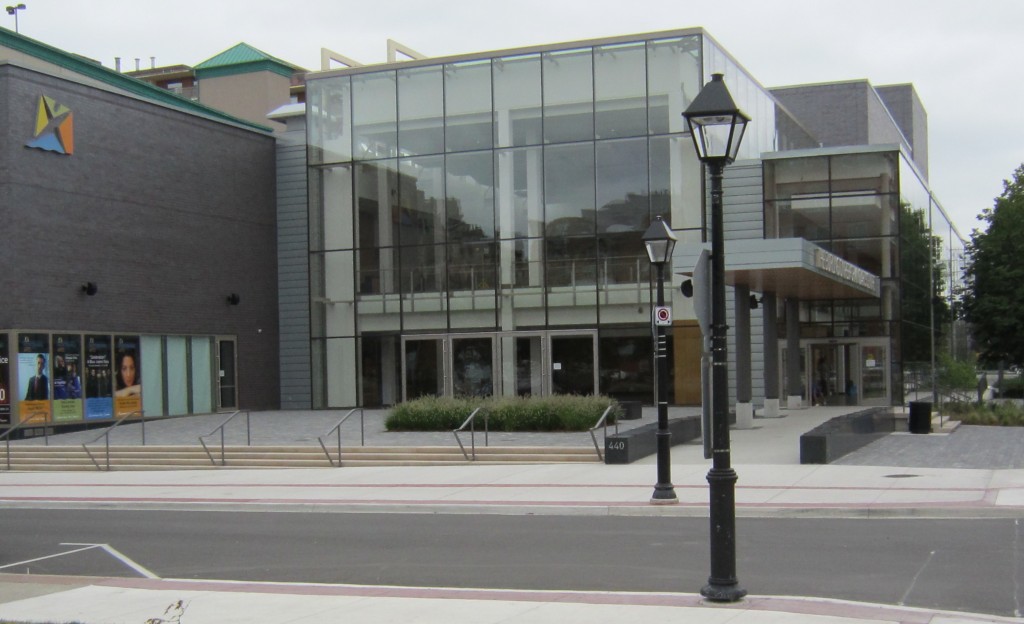 Burlington based artist and Our Burlington columnist Margaret Lindsay Holton wants to see Burlington artists at least considered in the selection process. None of the artists who made the final three are from Ontario. One is from Quebec, one from New Brunswick and the third from Maine, USA. Photo by Our Burlington It concludes, “By reflecting a community’s values, and its past, present, and future, public art can embody and symbolize a community’s sense of identity.” (Italics mine.)
According to the public survey done for this Master Plan, Burlingtonians overwhelmingly identify with the thematic subject of “local history”, followed closely by “the natural environment”. Take note of that – ‘local history’ and the ‘natural environment’. We will be coming back to those two heartfelt perfectly natural themes of identity in a moment.
So, just so you that know, the above was, and remains on the City of Burlington website as, the stated purpose of the City of Burlington’s ‘Public Art’ initiative.
However, most interesting about Burlington’s Public Art Master Plan was City Council’s abdication of the responsibility for actually running the Public Art program. Instead, Council voted, in 2009, to let an ‘external body’ handle it. And there, to my mind, lies a bit of a problem. An ‘external body’ active in Burlington, is one thing, but an ‘external body’ outside of the City limits is quite another.
In 2009, the City’s Public Art Reserve Fund had $186, 578 on account, with another $190,000 ‘pending’. Today, that annual fund, topped up by various agencies of the Government of Ontario, has allocated approximately $250,000 to that ‘external body’ in the form of one Jeremy Freiburger, Chief Cultural Strategist of Cobalt Connects, of Hamilton, Ontario, Canada.
Mr. Freiburger was hired by the City of Burlington to implement not only Burlington’s Public Art program but, latterly, a Cultural Action/Policy Plan too. Jeremy certainly is an engaging and charming fellow who is struggling somewhat to ‘make it happen’ here, BUT, why didn’t City just align with the long-established ‘Creative Burlington’ group? You know, the group that had to close shop in 2011 because there was insufficient City funding for them to continue to operate. With no track record in this community, Jeremy Freiburger’s Cobalt Connects, has, within just three very short years, received over TEN times the funding that the grassroots ‘Creative Burlington’ group was begging for from Council to stay afloat.
…. hmmmm ….
How can a Public Art program in Burlington, one that is both meaningful and significant for developing a ‘rooted’ Burlington identity, be developed by, and decided by, an ‘external body’ from outside the City limits? In other words, WHY does the City of Burlington have to go to a self-professed “entrepreneurial” Hamilton-based arts-bureaucrat to FIND the Roots of our own cultural identity?
Something is missing in this cultural equation. That missing component is, in fact, us, the actual living breathing communities that comprise the City of Burlington – from established Aldershot to newly developed Alton, from rural Lowville to the developed Lakefront, from tony Tyandaga to solid Mountainside, from sprawling historic farmlands of the north to the apartment blocks and heritage roosts of the downtown core. Within this Public Art ‘dialogue’ we, as Burlingtonians, are sadly missing the one element that makes Burlington so culturally unique, our very own voices.
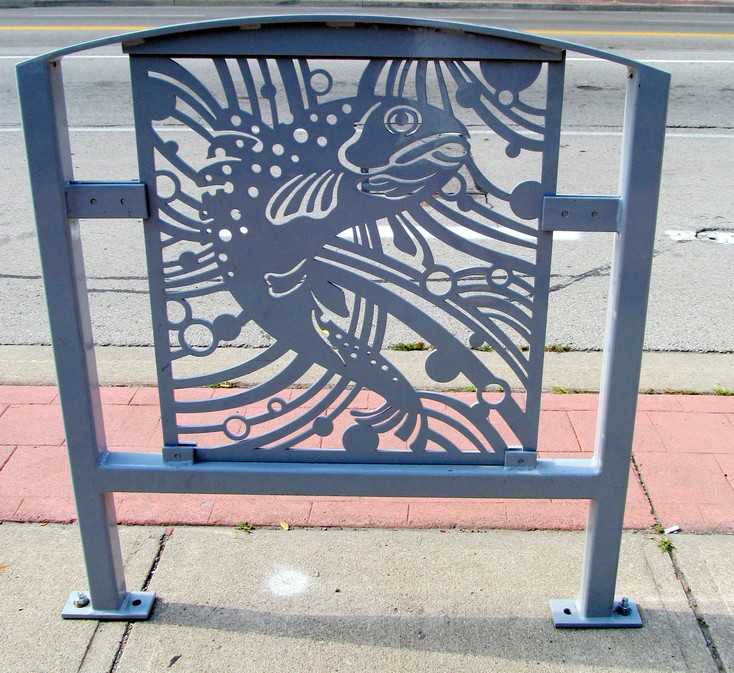 Yes, they are bike racks. You won’t get arrested or ticketed for attaching your bike to one of them. One of recent Burlington Public Art initiatives, of 2010, administered by Jeremy, was the development of these bike racks. Yes, that is what they are. (Promise, you won’t get arrested or ticketed for locking up to one.) Over 180 designs were submitted by 76 ‘international’ artists until 10 designs, chosen by Jeremy and his appointed ‘independent’ jury, were placed on a shortlist. After a public vote, six finalists were paid $1500 each for those designs – Martyna Dakowicz, Jen Hsieh, Zhiyang Mao, Kyle Reed, Wesley Tsang, and Xiaojing Yan. Not one is an active Burlington-based artist, or has ‘roots’ here. Perhaps that is why these bike racks have FAILED on two accounts: 1) as bike racks – [have you ever seen ANY bike locked up to these objects over the past year?] and 2) as ‘local’ Public Art. Admit it Jeremy, few here have any idea what these cut-out metal thingys bolted to several downtown sidewalks are all about …
The Palladium Park Public Art Benches Competition of 2011 was no different. A talented artist from Kitchener-Waterloo received the commission, not one of Burlington’s own.
Sure, call me parochial, but how, exactly, can the heralding of Burlington’s cultural spirit, local history and natural landscape begin with ‘outsiders’? It’s like having a paid professional singer sing our favourite childhood lullaby from a hastily composed score, rather then singing in chorus, with one heart and soul, by rote, what we all know and love so dearly. (A tad hyperbolic, but methinks you catch my drift.)
Surely the point of this exercise, in all its forms, is to celebrate our own, to support and promote the struggling ‘grassroots’ art community here, and by so doing develop and reflect a truly Burlington-based arts culture. No? On the other hand, perhaps the REAL Public Arts objective, as the ambitious Jeremy Freiburger and his select ‘external body’ of jurors interpret it, is not at all about the nurturing of, or the reflecting of, Burlington’s ‘sense of identity’, past or present. Rather, perhaps their end objective is simply to create a generic ‘urban beautification’ of Burlington for well-heeled out-of-towners (and investors) using titillating ideas by “recognized” artists who have no cultural or spiritual connection to this place. Or, perhaps, the purpose is to create a roster of “recognized” artists who, hopefully, (no guarantee), will someday garner an international reputation that will substantially inflate their monetary worth, and thus, increase the investment holdings of the City of Burlington Corporation’s Public Art Inventory. Perhaps. Who knows. One thing is clear, the PURPOSE of Burlington’s Public Art program is slowly, and somewhat stealthily, tip-toeing away from the standing Public Art Master Plan.
Anyway, for sake of argument, let’s assume for a bit that the REAL objective, (not the one so meticulously outlined in the PAMP), is to develop a no-name ‘pretty suburban city’ dotted with public art works by artists-from-elsewhere whose careers will continue to develop far away from the City of Burlington. With this revised concept in mind, we can better understand Mr. Freiburger’s jury’s choice of three finalists for the Burlington Performing Arts Centre Public Art Competition. More at the public art web site.
 From the top left, going clockwise – the Cooke Sasseville submission, the Spiral Stella by Peter Powling and the In the Round by Aaron Stephan. The three finalists with concepts, clockwise, are: Cooke-Sasseville from Quebec City. Concept: ‘Stay Connected’, 15ft x 7ft, an abstract ‘technical console with cables’. Peter Powling from “the hills of New Brunswick”. Concept: ‘Spiral Stella’, 16ft high x 30 inches wide, sky reflecting bronze obelisk. and Aaron Stephan from Portland, Massachusetts, U.S.A. Concept: ‘In the Round’, circular 28 foot disc covered with 15,000 pixel-people on globe. Not one of these evidently talented artists is from Burlington, or even the Golden Horseshoe region of Southern Ontario, Canada.
Obviously each artist has devoted a great deal of thought to develop a ‘Public Art’ concept that ‘reflects’ Burlington’s identity back to itself (sort of) and each idea stands as an indisputable ‘Burlington Public Art’ monument that will eventually engender local community pride and a long term legacy of some kind. Still, it seems a great pity to me that not one of these fine artists is from here. I mean, there isn’t even a finalist design concept from the very talented, locally-minded and “recognized” Les Drysdale, who, though admittedly not a Burlington native, is, at least, from the Golden Horseshoe region. His work can be seen on his web site.
How appropriate it would have been to have one of Les’s evocative story-evoking ‘local history’ statues grace the square at the Burlington Performing Arts Centre of, love him or loathe him, the indisputably talented Jim Carrey. Imagine a multi-dimensional fully animated vignette by Les – of Jim – as ‘The Mask’, the ‘Grinch’, and the ‘Joker’ characters all rolled into one piece. It would celebrate local talent on multiple levels, (Jim grew up in Aldershot), successfully promote the Centre as a ‘living’ arts showcase, inspire local and visiting performers, and nudge all of us, as a community as a whole, to identify with the ‘Dream Big’ ‘Just Do It’ persona of Jim. It would also, I believe, be an engaging and memorable tourist attraction. And it could all be done for the $90,000 commission prize fee. Ah well, simply put, this kind of ‘from here’ idea has not been “recognized” by the jury. And more’s the pity, I say.
Let’s re-consider all this, for a moment, from a slightly different perspective.
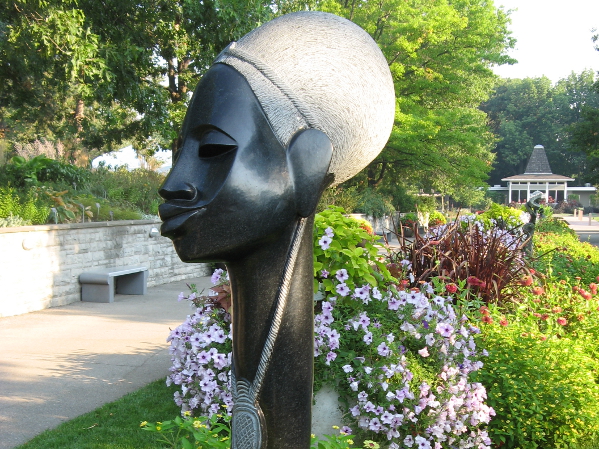 Sculpture by Shona artists reflect their homeland culture & sense of identity. ZimSculpt is currently showing at the Royal Botanical Gardens (until October 8th). Two talented and soulful sculptors from the Shona tribe, Passmore Mupindiko and Patrick Sephani, are carving up million year old rocks especially imported for this exhibit from their home country, Zimbabwe, Africa. Now imagine that. They have imported huge hunks of stones from their own mountains to carve here. Voluptuous stone sculptures crafted by their own tribemen’s hands abound throughout the Hendrie Gardens. These bold sculptures really are powerful art objects: thematically, technically and culturally. Cumulatively, these Shona-made sculptures reflect a profound ‘sense of identity’, from a wholly unique place on the planet, Zimbabwe.
 These Shona-made sculptures are part of an exhibit currently at the Royal Botanical Gardens. Now, flip it. Imagine a roster of Burlington-based sculptors (or artists), who are supported and “recognized” by our very own City Council (or equivalent ‘external body’ made up of Burlington art enthusiasts). Imagine them going to Zimbabwe (or France, or anywhere else) to showcase their powerful works in a high-profile public art space. Imagine them as they chip away at their own imported ‘mountain’ rock – the Niagara Escarpment. All who see – and buy from them – would know these talented artists reflect an equally profound ‘sense of place’. Why? Because these respected artists reflect another far off Earth location, one with a wholly unique natural and local identity. And yes, these soulful and talented artists ARE from that wonderful place of Burlington, Ontario, Canada.
…. Get the picture?
If we don’t believe in our own, nobody else ever will either.
Culturally-diverse earth roots are not only important, but essential. Without them, we just become rootless, isolated and detached global misfits, flipping the dials, pushing the buttons, endlessly searching … searching … searching … for the one place we so studiously ignore at our own communal peril – Home.
Ask Patrick, ask Passmore, those soulful Shona sculptors representing their far off village communities of Zimbabwe. Now, ask the diverse voiceless village communities who live harmoniously within the City boundaries of Burlington, Ontario, Canada. Ask the artists who live, work and play here. They, and we, all know that: not only does ‘Charity begin at Home’, but home really is where our Heart – and Art – is.
Margaret Lindsay Holton is both an environmentalist and a community activist. She is an artist of some renown and the designer of a typeface. She is also a photographer and the holder of opinions she will share with you in an instant. She appears as an Our Burlington columnist every two weeks.
© Photography and photo montages by Margaret Lindsay Holton, 2012, unless otherwise noted.

 By Pepper Parr By Pepper Parr
BURLINGTON, ON September 11, 2012 After many months of keeping everything under wraps, Jeremy Freiburger finally opened the curtains and is letting the public see what the three Burlington judges have chosen as finalists for the public art that is going to stand in front of the Burlington Performing Arts Centre.
Burlington is slowly learning that if you want the public to buy into an idea – let them know what you are up to; ask their opinions and listen to what they have to say.
You can view models of the three finalists at the Central Public Library or see large photographs at City Hall and Tansley Woods – and that is about as far north as the public viewing will go. Something for the city to look into – the people north of Upper Middle Road are just out of luck when it comes to knowing much about what goes on at city hall, unless they want to drive well outside their community
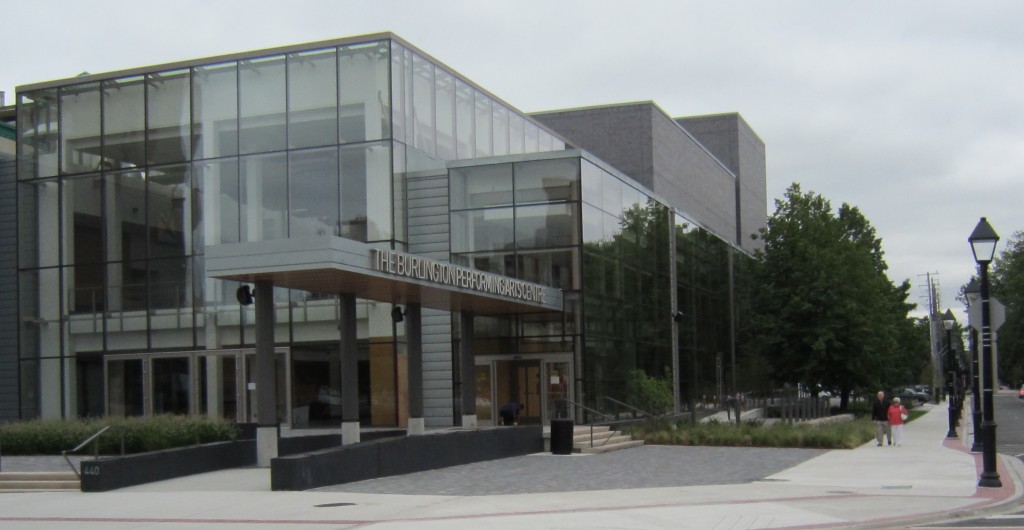 The currently unadorned Performing Arts Centre may soon get some public art. The plans are to place the art in the small fore-court – shown in the right of this photograph. Art is a very subjective thing. Many people feel that they know what they like the moment they see it – and that is certainly true. But taste is something that is developed; something that evolves over time. That development takes place when you see and experience different forms and examples of art. Some feel that public art should come from within the community – others feel the search should be world wide.
The judges are: Ian Ross, executive director of the Burlington Art Centre, Emma Quinn, executive director of the Ontario Craft Council, Trevor Copp, artistic director of Tottering Biped Theatre, Natalie Eldershaw, 4th-year Sheridan College art student.
The steering committee that oversaw the process included: Avery Brooks joiner – local youth involved in Culture, Dan Lawrie – project donor; Brenda Heatherington – BPAC Executive Director, site stakeholder; Mary-Ellen Heiman – member of BPAC Board and Denise Beard, Acting Manager of Community Development Services for the city of Burlington
The three finalists, chosen out of the 119 submissions to the Call for Submissions the city put out in March of this year, were asked to then create a small model and provide some detail on what they proposed to create.
Those models are now on display at the library on New Street
The project got its start when Burlington businessman Dan Laurie expressed an interest in sponsoring some public art that would be placed in front of the Performing Arts Centre, at the intersection of Elgin and Locust streets in downtown Burlington. Laurie put up $37,500 of his own money and the city used $75,000 from its Public Art Fund
The Cooke-Sasseville submission, Stay Connected, is made of stainless steel; aluminum; powder-coat paint. It is 15 feet high x 27 feet wide.
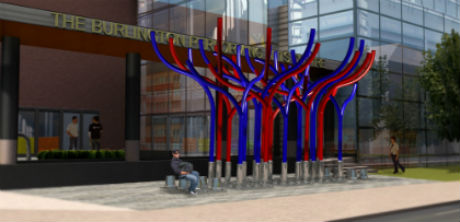 The Cooke-Sasseville submission is certainly the most colourfull of the three. How will the bright colours stand up to weather over the long haul? In explaining their submission Cooke-Sasseville had this to say: “We are proposing the creation of a monumental and playful sculpture that stems from the idea of representing, on an exaggerated scale, a well-known, easily identifiable object that is closely tied to the performing arts: a technical console and connecting cables. Our proposal is visually striking and evocative in its usage of space and it will transcend the objects that it represents, becoming an almost abstract work that brings to mind both vegetation and the human circulatory system. The work will be firmly fixed to the ground and expand into space in a systematic manner, schematizing a perfectly orchestrated choreography where the notions of movement, exchange and transmission are represented.”
“The work that we are submitting suggests a never-ending openness towards the sky and it may be interpreted in many different ways, from the simple representation of everyday objects to the schematization of complex fractals. In doing this, we wish to glorify that which may seem banal but which is really essential, or that which is not seen but which plays a crucial role in the creation of major artistic productions: the technical side of the production as well as the importance of collaborations, human contact, encounters and communication.”
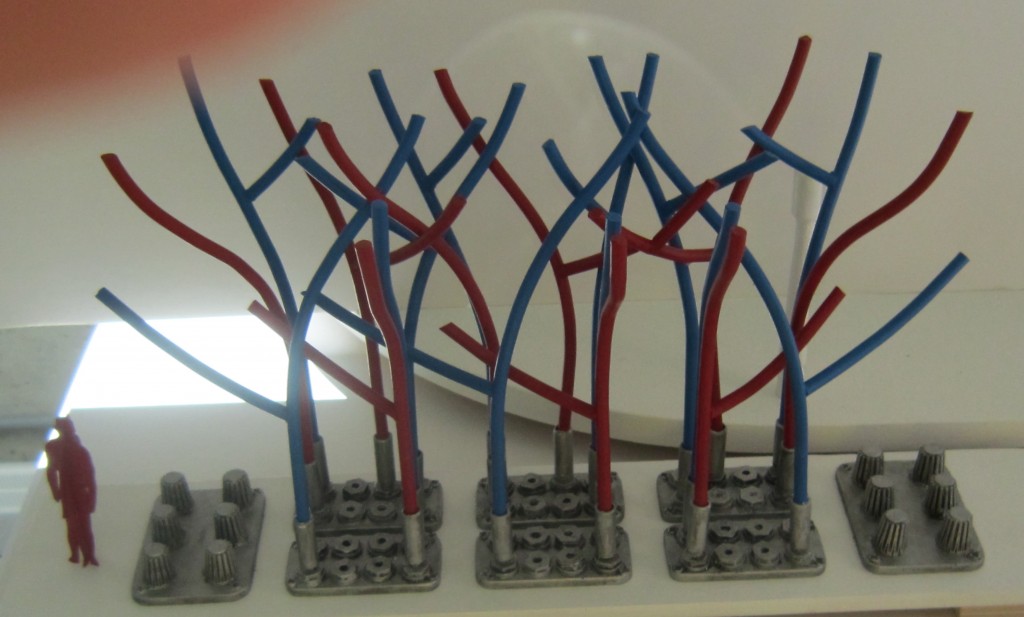 A scale model of the Cooke-Sassville submission. These Quebec based artists have done a significant amount of public art work throughout North America. The Peter Powning submission, Spiral Stella, is to be made of stainless steel; cast bronze and stand 16 feet high and be 30 inches wide.
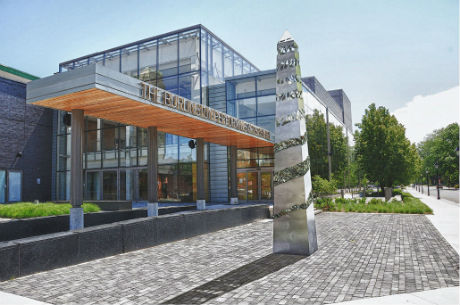 The Spiral will be 16 feet tall and include in the bronze casting artifacts from the community that could well make this one of the most intriguing pieces of art in the city. Powning explains his submission this way: “My intent with this proposal is to produce an iconic sculpture of scale that has impact from a distance but which also provides an intimate experience up close. I propose a sculpture that offers an opportunity for discovery, an enhanced sense of local identity, and education opportunities; a community touchstone honouring Burlington and the Performing Arts Centre; its history, natural environment, culture and identity. A key element of this project will be community participation in providing important cultural and historical artifacts to include in the cast bronze spiral. I think of this bronze relief as cultural mulch, incorporating artifacts from the historical to the contemporary.”
“The elements I will be working with are meant to balance content and form in a dynamic approachable sculpture. The obelisk will reflect the sky, patterns of cloud and ambient light, changing hues as the day progresses, the cast bronze provides visual and textural contrast as well as an intimate tactile experience. The formal obelisk shape organizes the various parts of the sculpture in a unified, recognizable whole. In close proximity, it reveals a material richness with layers of cultural content gathered from the people and institutions of Burlington in cast bronze relief. From a distance, this monumental sculpture will be visible as a landmark.”
 The section that appears in blue is the part within which the artist will include local artifacts. No one knows at this point what will be included if this submission is chosen – but if it is chosen – expect everyone in the city to come up with something – it’s going to be out there for everyone to see for at least 50 years – perhaps forever. What doesn’t become immediately evident in the artists comments is that the people of Burlington will contribute a large part of the Spiral – and he has no idea what the public contribution will be. Somehow, what people want to see included in the spiral will get to the artist who will include it in the final structure. That could be very informative and certainly reflect the community.
Aaron Stephen calls his submission In the Round which will be made of cast zinc alloy; architectural zinc sheet and have a diameter of 28 feet.
 The In the Round submission is far more complex, and intriguing, than evident in this picture. That globe graphic is made up of more than 15,000 small figurines. Interesting approach but the location and the height of the art will need some consideration. “In the Round”, says the artist, “is composed of over fifteen thousand small human figures traversing the wall of Burlington Performing Arts Centre’s fly tower. Each three-inch metal figure interacts in a unique way. Some mill about, some talk, walk, or just look around – simply depicting a crowd of individuals interacting as we do in everyday life. From a distance the minutia of this crowd disappears while a larger whole becomes apparent. Each individual figure acts as a pixel defining the collective image of a twenty-eight foot world globe.”
“Anyone who has attended a live performance has experienced the curious moments that immediately precede the actual event. In the lobby, crowds mill around and everyday conversation takes place. There is a unique energy in the air that can only be described as communal anticipation. The evening takes a turn as the performer(s) appear on stage. In a brief moment, what previously seemed to be a haphazard group of audience members becomes a single entity.”
“Like the distinctive beginning of a live performance, In the Round encompasses the same feeling of anticipation, movement, and energy. It represents the moment in which the community of Burlington becomes fully engaged and implicated with those on stage.”
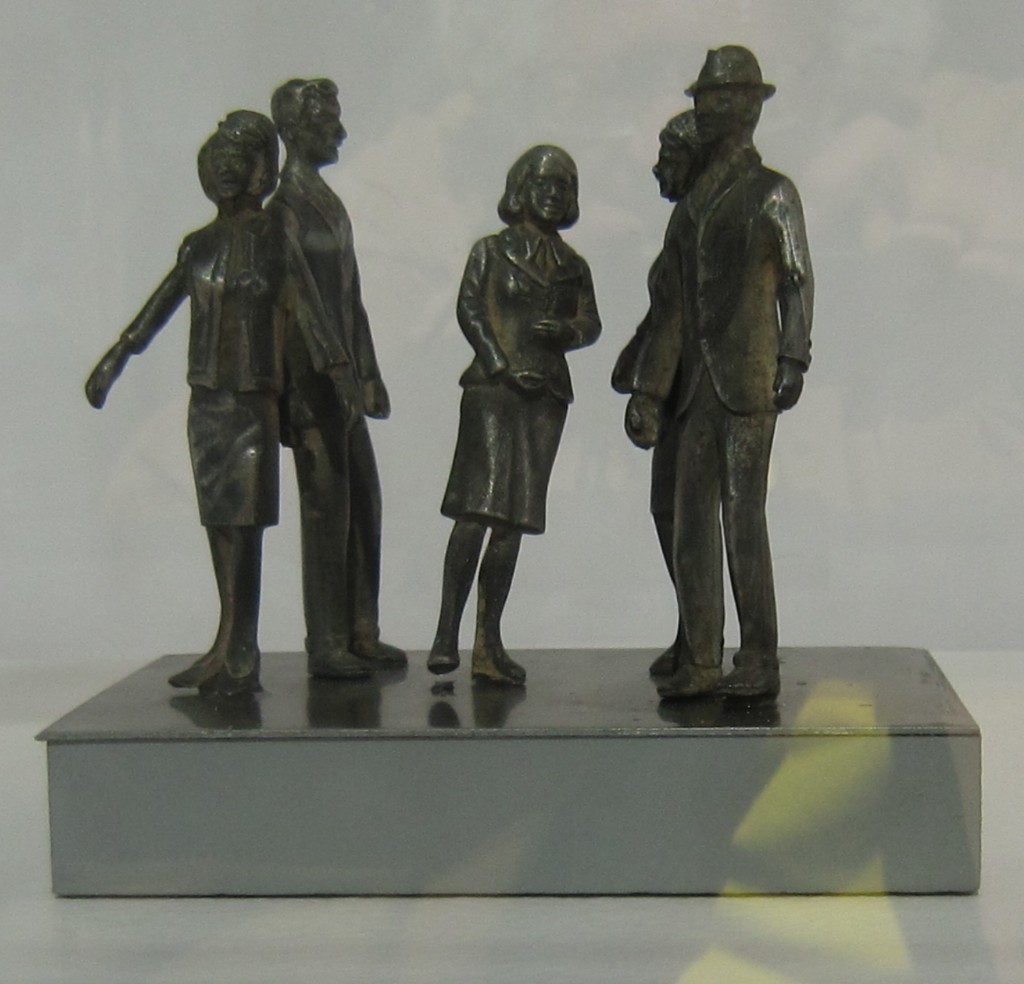 Examples of the more than 15,000 figurines that will be used to shape a graphic of the globe in the In the Round submission. The “official” illustration doesn’t do justice to this submission. That it will be at the back of the theatre is a limitation. What is shown in the official picture is a graphic of the world – what you don’t see is the 15,000 little figures that will make up the globe.
All three submissions have merit. Several are unique in the approach they use to involve the person looking at the art.
The city has asked the public to “Tell us what you think!” and have provided a place on the city web site for comments on all three pieces of art. Log into WHERE and tell the city what you think. If you can – get over to the Library, and look at the maquettes (fancy word artists use when they really mean to say a model of what they have in mind)
There are also ballot like forms upon which people can write their comments.
The judges will review the comments and come to a final decision. That final decision doesn’t have to be the selection of a specific piece of art.
The three judges chose three submissions – they could have chosen five or ten but there wasn’t enough money in the budget to give every artist the $1500 grant to prepare the model.
Once the judges go over all the comments they will decide which of the three submissions should become the art that will be placed outside the Performing Arts Centre. The judges do not have to choose one of the three finalists – the decision they make will depend on the public feedback.
The challenge for the judges is – are they going to lead public opinion and help shape it or are they going to follow public opinion. Attempting to lead public opinion in Burlington is not always a rewarding endeavor.
If public opinion is strongly against any of the three submissions the judges can decide that none of the three put forward is what the public wants. What do they do then – and why were just three of the 119 submissions selected?
The selection process had two parts to it. First review everything that came in and then invite the three the judges thought were the best and ask them to prepare a model of what they were proposing. Each artist was given $1500 to build their mode. There wasn’t enough in the budget they had to work with to invite more than three.
This is the second major public art project for Burlington. The “orchids” ,done by Irish artist Alex Pentek, were liked by many – but just as many couldn’t understand why it was placed in the middle of busy Upper Middle Road, where it is extremely difficult to see the art as you duck under the railway overpass. Very poor location.
The Performing Arts Centre is seen as a prime public site and with the right art it will be something people will come to see; providing the city selects what the public is prepared to accept.
Make a point of getting to the library to look at the models. And let the city know what you like and don’t like – and add why you like what you see as well.

 By Staff By Staff
BURLINGTON, ON September 10, 2012 The 62 year old school bus driver involved in a collision while driving a school bus near Bronte Harbour in Oakville last week has succumbed to his injuries.
Jim Leroux, of Burlington, passed away Saturday morning at Trillium Health Centre in Mississauga. Recently retired, Mr. Leroux started working as a school bus driver last year.
The Leroux family would like to thank those members of the public and emergency services personnel for taking care of him at the crash site.
 Burlington driver of school bus that crashed in Oakville succumbs to his injuries. Cause of death not released. Police will not be releasing the cause of death. The Coroner will be making that determination in the next 30 days.
The bus, operated by Attridge Transportation passed a mandated MTO inspection in July of this year.
A mechanical inspection of the bus by police revealed no mechanical defects.

 By Pepper Parr By Pepper Parr
BURLINGTON, ON September 10, 2012 The team was supposedly shut down because they couldn’t field a full squad – but that wasn’t the way the Bateman Wilds saw things so they took to the streets with an early Monday morning sidewalk protest in front of the school.
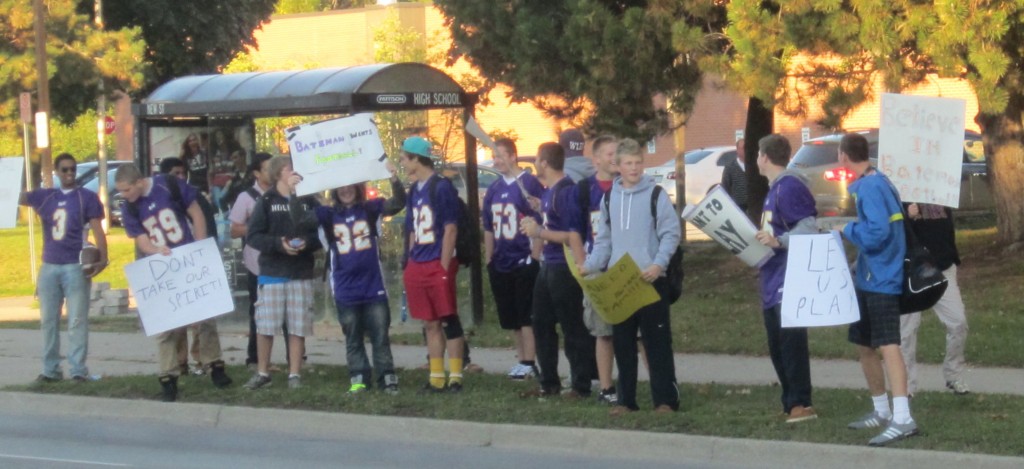 Bateman High’s Phys-Ed staff didn’t think the school could field a full squad and took steps to cancel the fall program. Football players took to the streets in protest Chris Bishop – certainly a football player given his size, was the spokesperson for the group and the person who sang the team cheer the loudest.
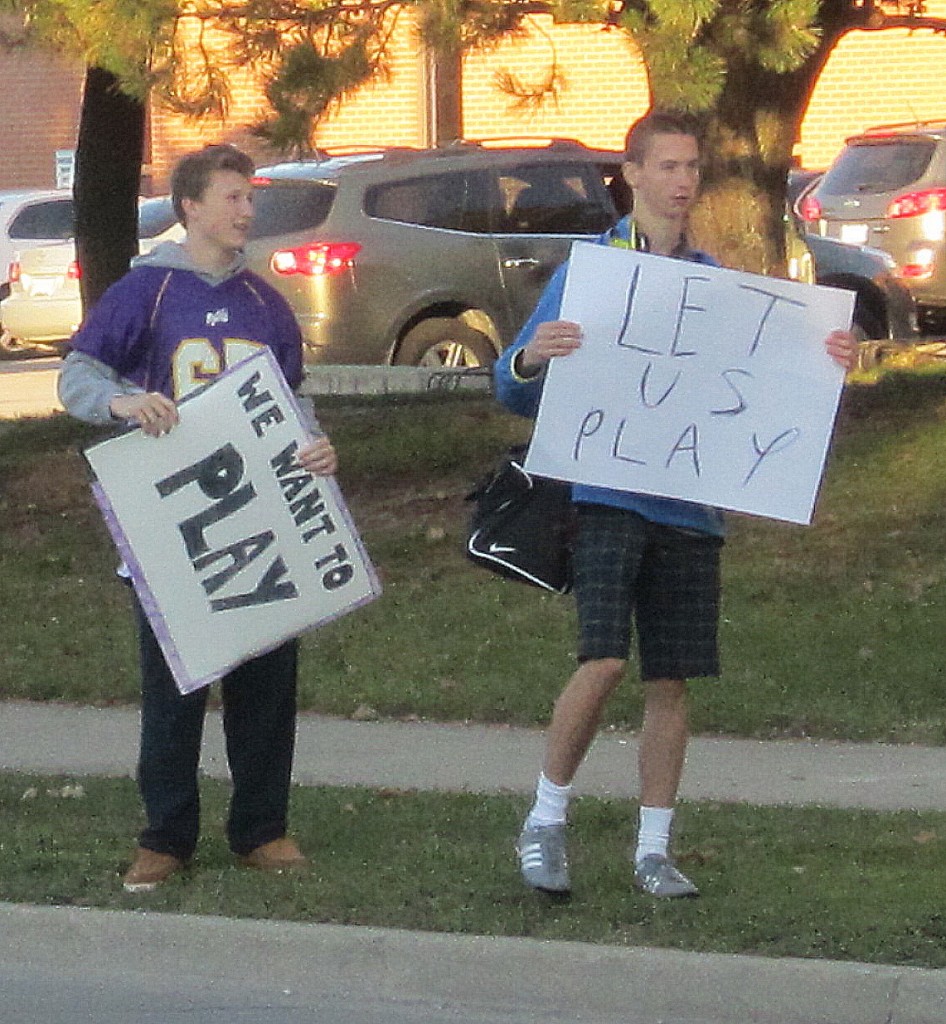 There are teachers at Bateman High that would like to see this much effort IN the classroom. The football players take their message to the streets. If a football squad needs 30 people, there were more than 30 enthusiastic students out there this morning. `We`re here for the day” explained Bishop, as he headed back to the fellow football players on the side walk exhorting every car that passed to honk their horns in support.
Bishop added that “if you put enough pressure on something there will be a change” and he fully expects the staff at the high school to rescind the decision.
Bishop thinks the school didn’t give the football players the time they needed to pull their team together and feels they acted a little too early in shutting them down.
 Not everyone at Bateman High focuses on football. This crowd, steps away from the protest, chats away before time to get into a classroom approaches. Different folks – different strokes. Bateman High, located on New street east of Appleby Line is your typical large school where cars stream into the driveway to let students out and buses slip in and out efficiently.
Many of the students knew nothing about the football protest. Like any other suburban high school there are different groups; the “fashion plates” are easy to identify; the geeks not so easy but they are there. The women on the field hockey team with their sticks in hand as well as the “couple” that have something going.
The chatter between the different groups is loud at times, but not unduly so. They carry a lot of books in those bags on their shoulders.
They stream off the bus that stops in in front of the school and all seem to arrive in large bunches.
 Female student casually dropped the donut wrapper on the ground and puffed away on her cigarette while enjoying her coffee. The wrapper, shown on the right, blew away into the street. Not the best or the brightest at Bateman High. There are the “cool” ones; the slightly older crowd who, the morning I was there certainly weren’t anything to be proud of. The smoking was bad enough – don’t they read? – but the blatant littering – one swishy female student just dropped the donut wrapper on the ground, while another cool dude with the crowd kept spitting on the sidewalk. They certainly weren’t representative of the crowd; this lot did little for the schools reputation.
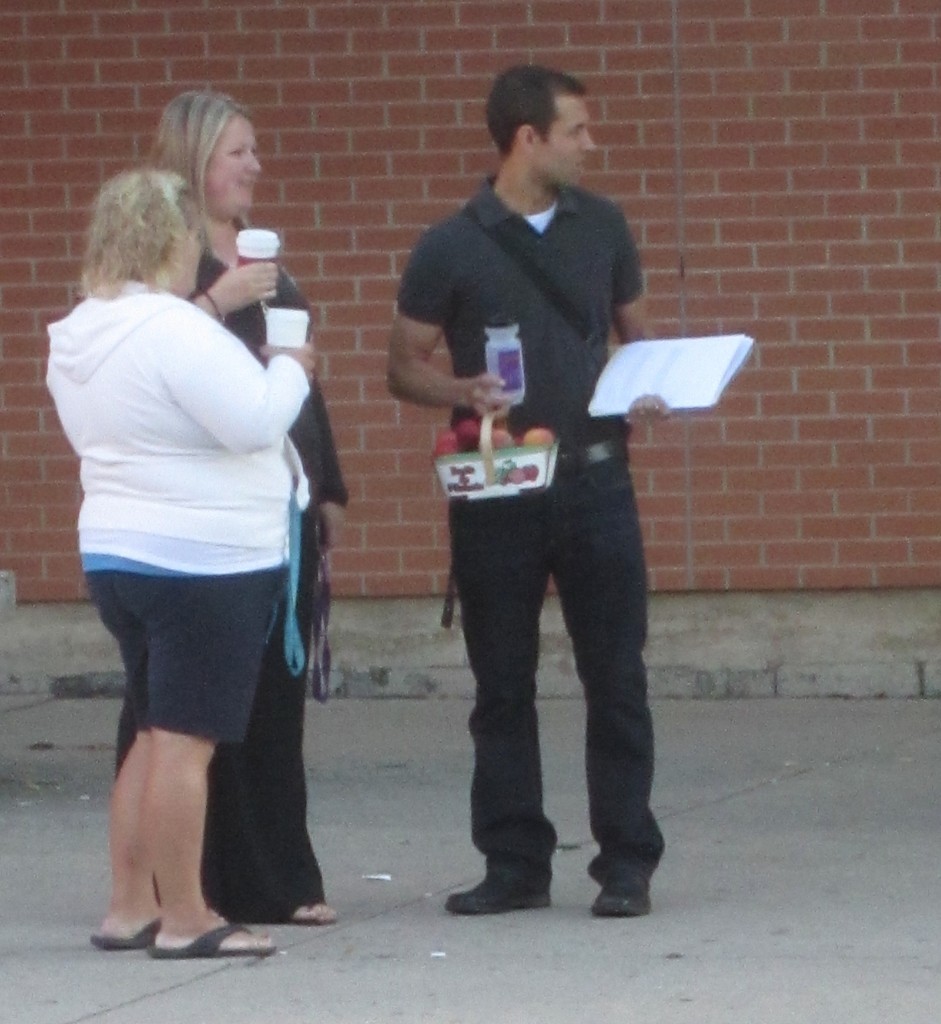 Bateman High staff look on as student protesters wave their signs and tell their side of the story. Can staff and students work this out? Will the Bateman Wild be on the field this season? Stay tuned The football players planned on being on the street for the day. At some point they will meet with the principal and the Phys-Ed people and work out a solution. Someone in the Phys-Ed department is wishing the students had shown this level of enthusiasm earlier in the football season. First practice is a couple of days away. Will the “Wild” be on the field? In strength?
Could this kind of enthusiasm take them to the finals?

|
|





























































































































